- Canoe Sailing
- Kayak Sailing
- Dinghy Sailing
- Snark Car-Topping Sailboats
- Canoe Stabilizers (Outriggers)
- Rowboat & Porta-Bote Sailing
- Parts and Accessories
- Boats (without sail rigs)
- Motor Mounts
- Portage Carts
- Small Outboards
- Specialty Boats
- Shopping Guide
- Testimonials


Snark Sailboats: Super Light, Super Fun!
More people have learned to sail on Snark boats than any other boat. Easy to sail, very portable, durable, and affordable!
This is the page for ordering a boat. See add-to-cart links in left column below.
Boat is shipped to your door. Shipping is put out to bid after you order. Expect $400 - $1000. You can cancel if bids are too high. Or you can drive to the factory (near Toledo, OH) and pick up yourself after ordering and paying.
Be patient. The process will take weeks at least.
Replacement Sails Parts
Limited Availability (updated July 26, 2023): Snarks are not yet back in production, but they have some factory seconds on hand at the factory that they are slowly going through to pick out the ones that are good enough to sell. The price is $1950 for a Sunflower or $1550 for a Super Snark, shipping not included. Only order if you will be patient and kind to us as we do our best to pry these boats loose at the factory, arrange shipping and get them out to customers. You will be charged only a refundable $100 deposit at this time when you click "Buy Now" below. The minor defect(s) that make your boat a second will be described to you before shipment and you will have the option to decline. The defects are cosmetic and minor. We've had no complaints about them.
New production is going to resume someday, but nobody knows when -- as in what year. The factory continues to take baby steps in that direction, buying parts and materials and getting production machinery ready.
We have many other portable sailboats available for your consideration. Please click here .
*Snark Boat Terms: Not returnable. Defects covered by manufacturer's warranty. Delivery dates are estimates only. Do not sign for your boat until you have determined there is no shipping damage. Refuse delivery if damaged
Sail Swap! Only at SailboatsToGo: Visit our Sail Swap page to select your sail if you want to when buying a boat. Or, for additional cost, y ou can upgrade to a white dacron sail or one of our premium Neil Pryde sails . Sail swap and white dacron upgrade offers apply only to new purchases of Super Snark or Sunflower from SailboatsToGo. .
“Snarks are so simple and fun to sail, but teach us worlds about working boat and wind together. I will admit, however, my favorite thing about the Snark is that I can decide to go for a sail on a lake 10 minutes from my door, and 15 minutes later I'm on the water. It is not a big event to go- so I go often.” John B. (Nov. 2010)
Why you should buy your Super Snark or Sunflower from SailboatsToGo.com: At SailboatsToGo, LLC all customer contct is handled personally by the owners, Jim Luckett and Rob Michael. You know you will get good advice, accurate information and expert service, because Jim and Rob are sailing enthusiasts, first and foremost. "Portable sailboats are my passion!" -- Jim Luckett
Snark Upgrades and Accessories
Snark Sailboat History
Boat Navigation Lights Rules: Illustrated Beginners Guide
When navigating at night, the lights on other boats are your first clue about the moving dangers around you. And your navigation lights are your first line of safety in avoiding collisions in the dark, and they tell others vessels what you are and what you are doing. The rules sound complex, but with a little understanding you can get the basics for any situation.
So what are the basic navigation light rules? For most small vessels, motoring requires red and green (port and starboard) lights, and a white light visible in all directions around the boat. This is almost always a stern light and a masthead light on sailboats. Boats under sail require port and starboard lights, and a white stern light. Sailboats below sixty-five feet may show a tricolor light at the masthead instead of side and stern lights when sailing.
That's it, in a nutshell. There's a little more to it, as the rules change with different sizes and there are some specifics about angles of display for the colors. Identifying other ships at sea requires more study, but the basics are the same. And it's not much trouble to make sure you've always got the proper lights on your vessel.
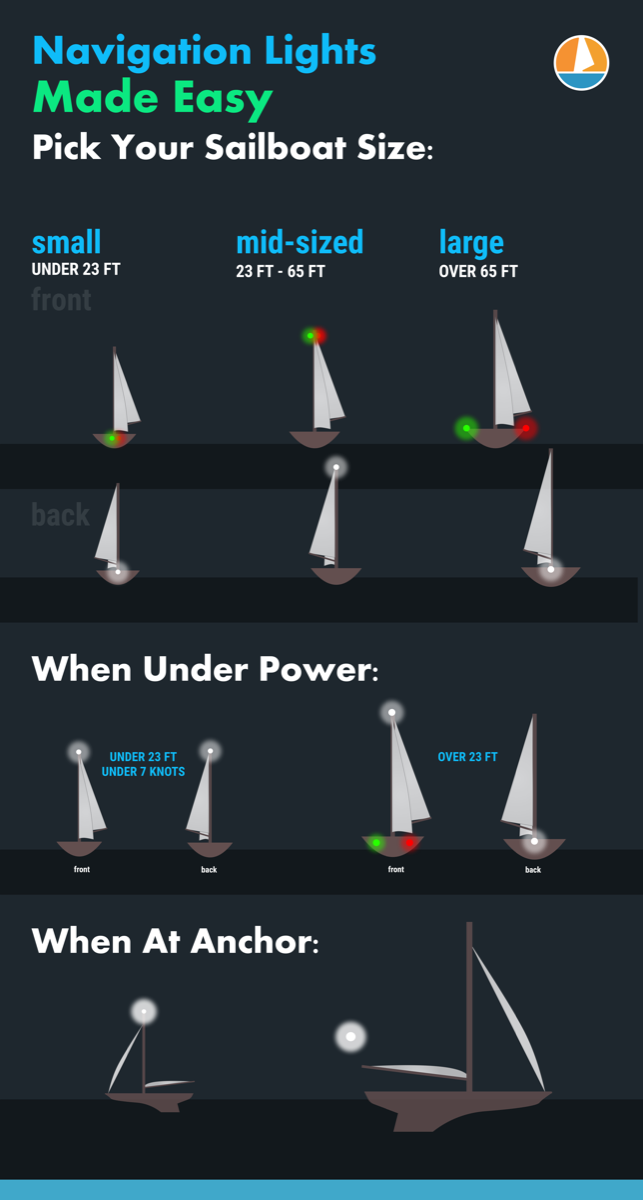
On this page:
What are the official colregs rules for your sailboat, what about the uscg (united states coast guard) rules, lighting at anchor, identifying the boats around you.
The International Regulations for the Prevention of Collision at Sea , abbreviated "COLREGS" is very specific about the lights required, their shapes and sizes, and the distance they must be visible. For the smaller boat, the following definitions apply.
- Masthead Light - a white light placed centerline on the boat showing an arc of 225 degrees with 112.5 degrees either side of the front of the vessel.
- Sidelights - A red light on the port side and a green light on the starboard. They must show an arc of 112.5 degrees from centerline of the bow.
- Stern light - A white light on the stern of the boat showing an unbroken arc of 135 degrees from centerline of the vessel.
- All-round light - A light showing in an unbroken arc of 360 degrees.
The good news is you need not measure these angles. Any properly installed USCG or COLREGS approved light which will cover the correct arcs. If you have to replace the original light from your boat, make sure it's with an approved replacement.
Lights When Sailing
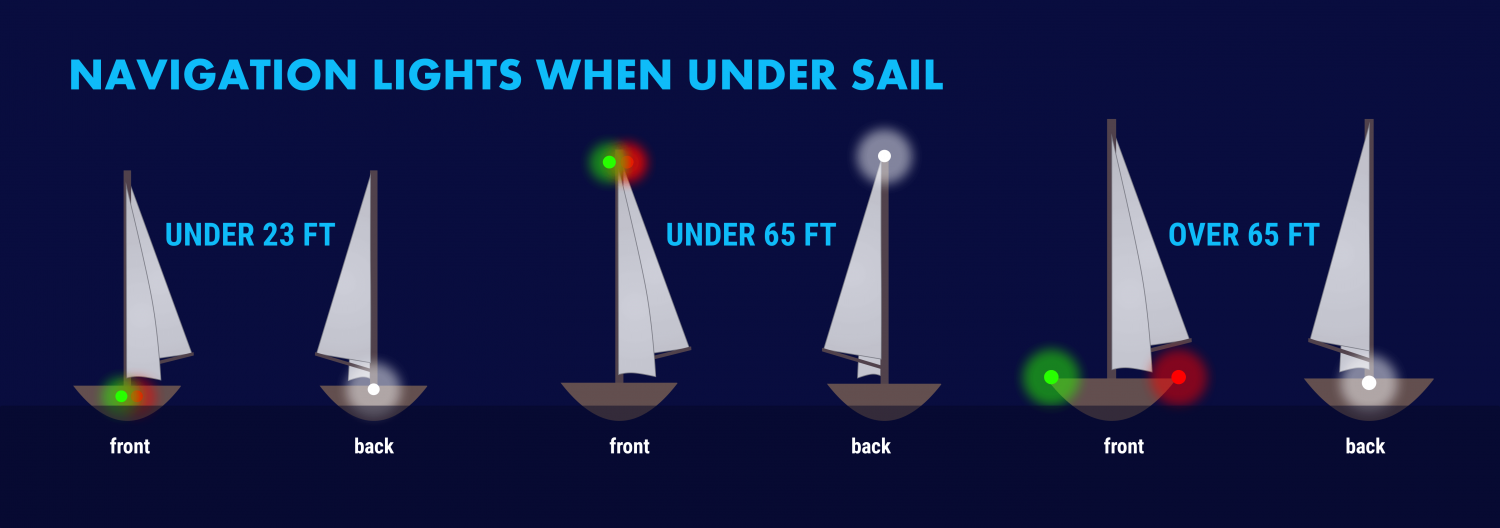
The specific rules for a sailboat under sail are in COLREGS Rule 25 and vary slightly with the size of the boat. A sailboat powering is considered a power boat and falls under in Rule 23.
- Under 23 feet (7 meters) - side lights and a stern light, possible. If these lights can not be displayed a light must be kept at hand to help avoid a collision. This can be a bright flashlight.
- Over 23 feet - Side lights visible to one nautical mile and stern light visible for two.
- Vessels under 65 feet may combine both sidelights into a single lantern on the bow.
- May show a tricolor light on the masthead instead of sidelights and a stern light. It's one or the other though, do not show these lights at the same time .
- Masthead light must be visible for three nautical miles, all other lights must have a two nautical mile visibility.
- Side lights must be separated.
- May not show a masthead tricolor light.
- Masthead light must have five nautical mile visibility, all other lights must be visible for two nautical miles.
- Optional masthead lights - any vessel under sail may display a red light over a green light at the masthead with sidelights and stern light. The red over green may NOT be displayed with a masthead tricolor light. It's one set or the other.
Lights When Motoring
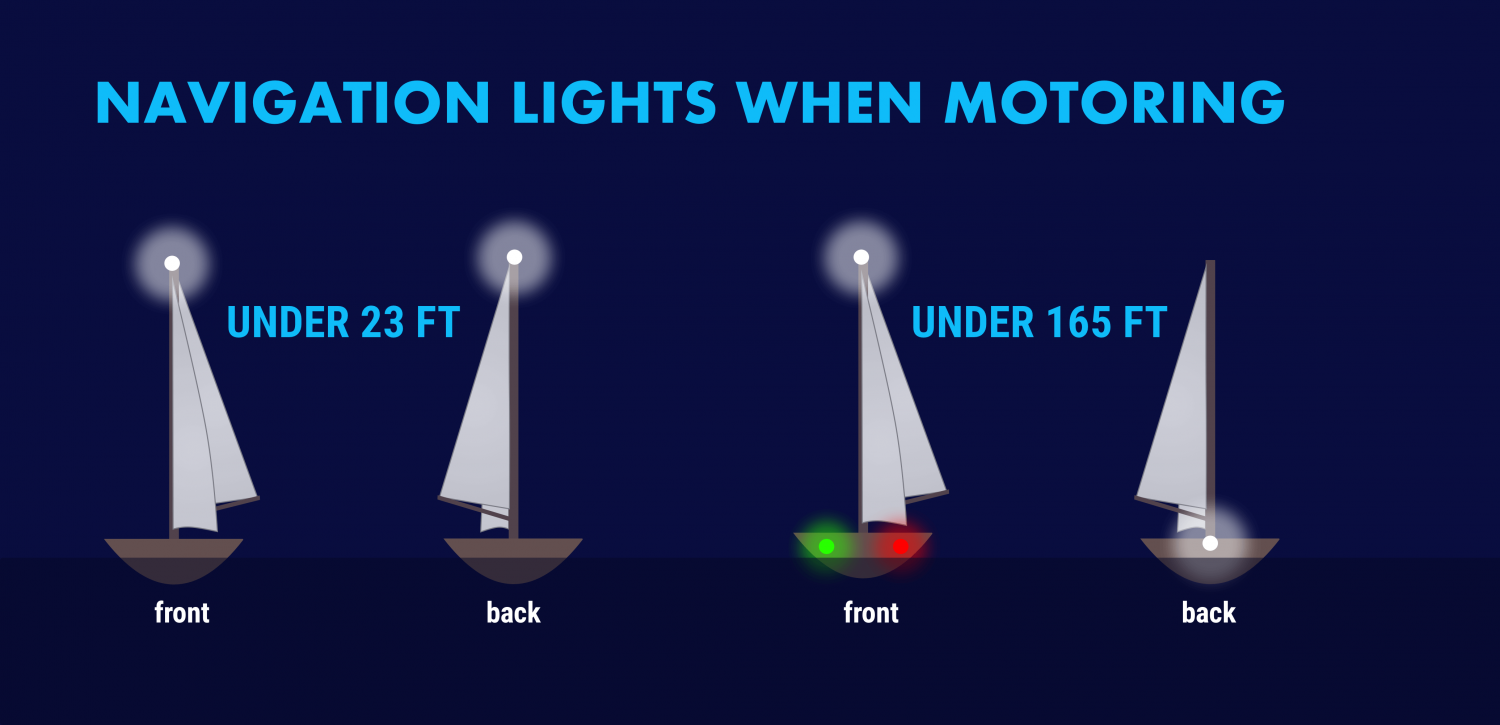
For all navigational purposes a sailboat under power is considered a power boat. This includes motor sailing - if the engine is on and providing propulsion you are on a power boat, even if the sails are up . This applies to navigation lighting, sound signals in fog and limited visibility, and rights of way.
Sailboats under 50 meters under power need to show:
- A masthead light
- Stern light
A power-driven vessel under 23 feet (7 meters) that does not exceed seven knots of speed may display an all around white light, though sidelights should be used if available.

The USCG has published its own "Rules of the Road" that are based on the COLREGS. In addition, it has rules for the "Inland Waterways" for rivers, inland lakes and the Great Lakes.
The good news is this has no impact on what you have to do with your own boat.
They mostly relate to lighting changes on towed vessels like barges and tugs. For example, a vessel towing or pushing another vessel in the ocean under COLREGS shows two masthead lights, sidelights and a stern light, whereas in Inland Waterways the towing or pushing vessel displays two yellow towing lights instead of a white stern light.
If you sail on lakes, rivers or the Great Lakes where towed commercial traffic is common you should learn the inland lights, but coastal or ocean sailors will never see these.
When you anchor outside a designated mooring field, you should display an all around white light at the masthead or as high in the boat as practical.
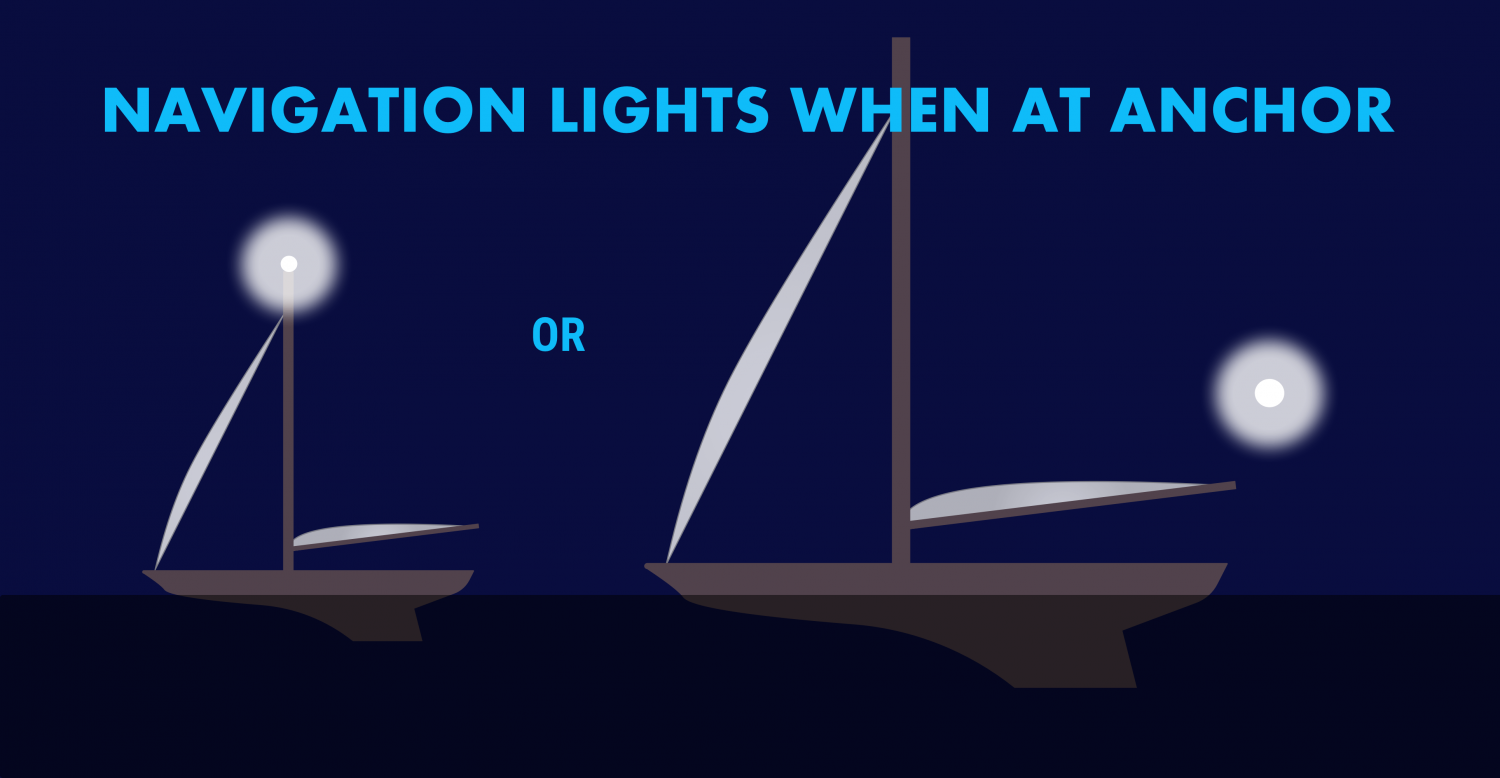
If your boat is large and has a very tall mast, you may wish to display another light closer to the waterline. Boats approaching in the dark may not see a light on a mast sixty or seventy feet in the air when they are close to your boat.
We use a simple garden path light on our stern when we anchor, left in a rod holder or flag socket. It comes on automatically at dusk and is a cheap and easy way to be more visible. There is no specific rule stating you can not display more lights than required, or the nature of any lights beyond the required all around light.
The COLREGS also specify that a round black "daymark" should be displayed in the rigging of any vessel at anchor. Very few small vessels observe this, however it is the correct display for a vessel in an anchorage.
If you tie to a mooring in a marked mooring area you are not required to display anchor lights, but there is no harm in doing so.
The other important reason to know your lights is to figure out what's going on around you at night. The water may be ablaze with white, red, green and other lights at night and they are your first key to avoiding collisions and problems.
All combinations of lights for fishing boats, commercial vessels, and so on are outside this post‘s scope. The odds are small you will encounter a submarine, seaplane or hovercraft at night, but there are regulations regarding specific lighting for each of those vessels!
There are a few fundamentals to help you figure out what that is you see on the horizon, which way it is going, and whether it is a danger to you.
Port Wine is Red
The fundamental rule is that red sidelights will ALWAYS be on the port side of a vessel, and green lights will always be on starboard. However, some vessels can use all around red and green lights for other purposes, though those will be higher than sidelights.

The light‘s on a ship is not important, some large tankers and freighters will have their sidelights far aft and put them on the superstructure for better visibility. It is not safe to assume that sidelights you can see are on the bow of large vessels .
When you can see the color, you know which way the bow is pointing. If it's red, it's pointing more or less to the left and will travel in that direction. A green light shows it is heading more or less to your right.
If you can see the red and green lights at the same time, you are looking directly at the bow of the vessel. When you are far away, this isn‘t as alarming as if you are close crossing. Seeing red and green lights together on a vessel is something you never want to see for long.
Be aware of red and green lights used in combination with other red, green and white lights. These may not be running lights and could have other significance.
Tankers, Freighters and Large Ships
Tankers, freighters and large ships will have side lights, a stern light and a masthead light. In addition, on vessels over 50 meters there will be a second masthead light further aft and higher than the forward light. The masthead light positions are a better tipoff to the bow direction and how far from the bow the sidelights might be. Remember - on a large vessel the sidelights may not be at the bow or even close to it.
USCG Inland Rules allow for a second all-around white light on large vessels on the Great Lakes instead of a second masthead light.
Fishing Boats
Fishing boats engaged in fishing will have more complex light displays. When they aren't fishing, they will show lights like any power vessel, but Rule 26 spells out light combinations that vary by the fishing activity being done. In general:
- Boats which are Trawling but not making headway will display a green all-around light over a white all-around light , and a masthead light aft of these lights. Boats making headway while trawling will show these lights, plus sidelights and a stern light.
- A vessel fishing other than trawling will show a red all-around light over a white all-around light . When making way they will also show sidelights and a stern light.
- If a vessel has gear more than 150 meters away from the boat, it will show a second all around light in the direction of the gear. The best rule is to give fishing boats as wide a berth as you can at night. They're easy to pick out if you check the top light configurations but their course may be difficult to predict.
Towing and Pushing
Towed vessels can be the most dangerous to cross, but they have the most lights to tell you what is happening. Refer to COLREGS or the USCG Rules of the Road Rule 24 for all combinations You can pick a tow/push vessel out with the following lights:
- Two or three masthead lights in a vertical line. Three masthead lights shows a tow over 200 meters. Additional masthead lights may show for larger tow vessels.
- A towing light (yellow light with the same characteristics as a stern light) directly above the stern light.
- The will also have side lights and a stern light.
- The towed vessel will show sidelights and a stern light. Lighting may vary under USCG inland rules, where towing lights may replace stern lights. Learn these differences if this is your regular cruising ground. If you think there is a tow ahead of you, always go well behind the aft most set of lights. Never go between a tow and avoid crossing ahead if possible as it may restrict their maneuverability.
Special Situations
There are several rare situations you may encounter. As a general rule, if there are a lot of lights and you don't understand them look for the sidelights on a moving vessel. If you can find them and figure out the direction it is moving, it makes the vessel easier to avoid. Stay well clear of lights you do not understand if you can avoid them without risk.
Most of these signals are used by larger, commercial vessels and you will not need them.
They use these light combinations with other light combinations. For example a towing vessel may also be restricted in maneuverability, and a vessel constrained by draft will show running lights if moving.
- Not Under Command - two all around red lights in a single line
- Restricted in Ability to Maneuver - red, white then red in a single line
- Constrained by draft - three all around red lights
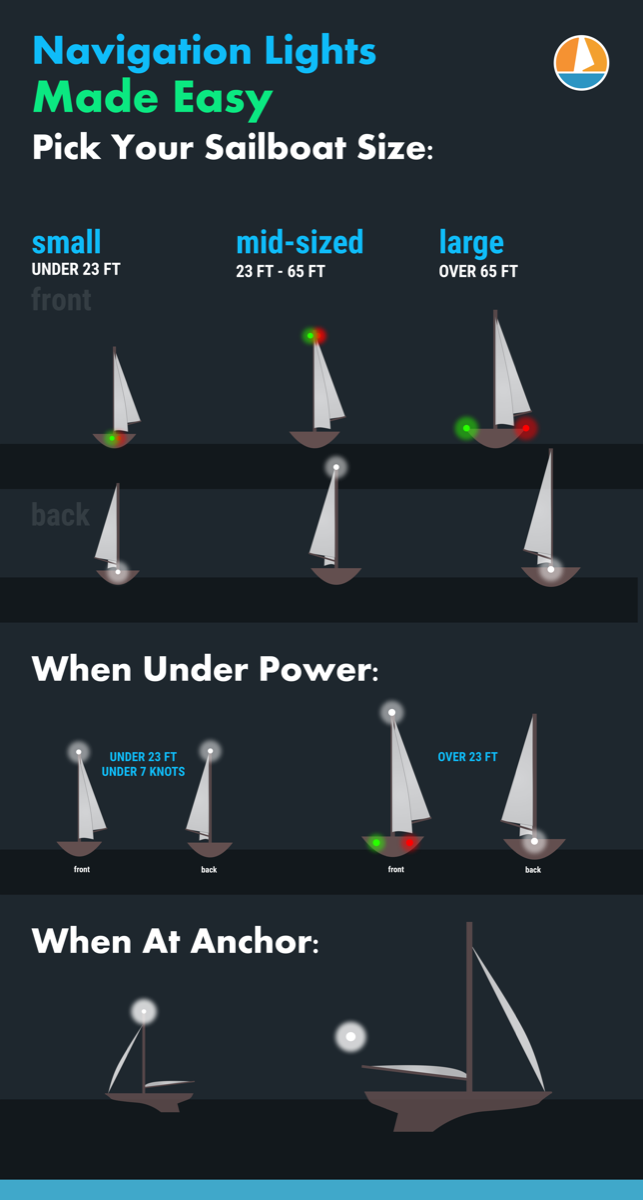
Leave a comment
You may also like, 17 sailboat types explained: how to recognize them.
Ever wondered what type of sailboat you're looking at? Identifying sailboats isn't hard, you just have to know what to look for. In this article, I'll help you.

The Ultimate Guide to Sail Types and Rigs (with Pictures)
Own your first boat within a year on any budget.
A sailboat doesn't have to be expensive if you know what you're doing. If you want to learn how to make your sailing dream reality within a year, leave your email and I'll send you free updates . I don't like spam - I will only send helpful content.
Ready to Own Your First Boat?
Just tell us the best email address to send your tips to:

- Forums New posts Unanswered threads Register Top Posts Email
- What's new New posts New Posts (legacy) Latest activity New media
- Media New media New comments
- Boat Info Downloads Weekly Quiz Topic FAQ 10000boatnames.com
- Classifieds Sell Your Boat Used Gear for Sale
- Parts General Marine Parts Hunter Beneteau Catalina MacGregor Oday
- Help Terms of Use Monday Mail Subscribe Monday Mail Unsubscribe
How do you light your cockpit at night?
- Thread starter dserrell
- Start date Nov 7, 2009
- Forums for All Owners
- Ask All Sailors
Stu Jackson
Lights Our boat came equipped with incandescent cockpit lights mounted on the SS arch. Works well. We also use a lamp oil brass hanging lamp at times. Do not need much light. Thread
Don S/V ILLusion
Lighting the cockpit and lighting for compliance with nav rules are exclusive issues which you sound like you are mixing together - which are you talking about as you mention both David? Strictly for purpose of providing ambient light in the cockpit, I've found the only good way to create wide-area light is using string lights which can be found in either 110VAC or 12VDC varieties and conveniently strung inside the bimini or dodger bows using very little power.
Don S/V ILLusion said: Lighting the cockpit and lighting for compliance with nav rules are exclusive issues which you sound like you are mixing together - which are you talking about as you mention both David? Strictly for purpose of providing ambient light in the cockpit, I've found the only good way to create wide-area light is using string lights which can be found in either 110VAC or 12VDC varieties and conveniently strung inside the bimini or dodger bows using very little power. Click to expand
Warren Milberg
I use an parafin oil lamp that I hang from a small chain under the bimini. We also use this same lamp inside the cabin. Provides a nice warm glow and enough light to do most everything except read. Bought this lamp new from eBay and was shipped from India for a total cost of $29. One of the best bargains I ever had for the boat....
Attachments

Absent a hard top or bimini, mount a small 12v light permanently to the underside of the boom. On an open boat I sold this spring (Stiletto 27) I mounted a small utillity light purchased from Advanced Autoparts (I'm sure you could find something nice and marine, but I liked the shape of this one). I shaped a piece of starboard to match the curve of the mast (passed over a table saw blade at an angle), sawed and sanded it to match the base of the light, and mounted it to the boom with screws and 5200. The wires run inside the boom to the mast, are exposed for a few inches, and then run down the mast. It is on the cabin light circuit, but has its own switch on the side of the fixture. VERY handy. It looked like a factory install when finished. You won't be able to imagine a cockpit without instant light. Would you buy a car without a dome light?
for my anchor light non my formosa i have a beautiful old oil lamp- --i found some cheepo garden lights --solar powered---from an outlet that takes in returns from costco--so these are 4-6 dollars each--lol--excellent light and cheeep and i can use many --as many as i want...for use as lights at anchor....even indoors after charging them in the sun all day!!!! i love my oil light for anchor--has fresnel lens and is visible for over 3 miles---is approved for use as anchor lamp, btw......
Light your cockpit at night in Maine & you're mosquito bait!
Cockpit lighting We have a couple of Japanese style paper lanterns that run on AA batteries. I usually just string up one of those.
Re: Cockpit lighting I just use a kerosene lantern both for my anchor light and my cockpit light when I want it. The CG does not specify the type of light just the range of visibility and a 1/2 inch wick meets the needs.
Dan Johnson
Davis... makes a handy low wattage lamp with a fresnel lens and a cigarette plug connector that can be used as an anchor light. I slip a notched plastic cup over it and hang it from a bimini crossbar for a neat cockpit downlight. Also have LED utility lights in the cockpit footwell for safe footing at night when docked (too bright to sail with).
- This site uses cookies to help personalise content, tailor your experience and to keep you logged in if you register. By continuing to use this site, you are consenting to our use of cookies. Accept Learn more…

Sailing Signals: Nautical Lights, Shapes, & Sounds
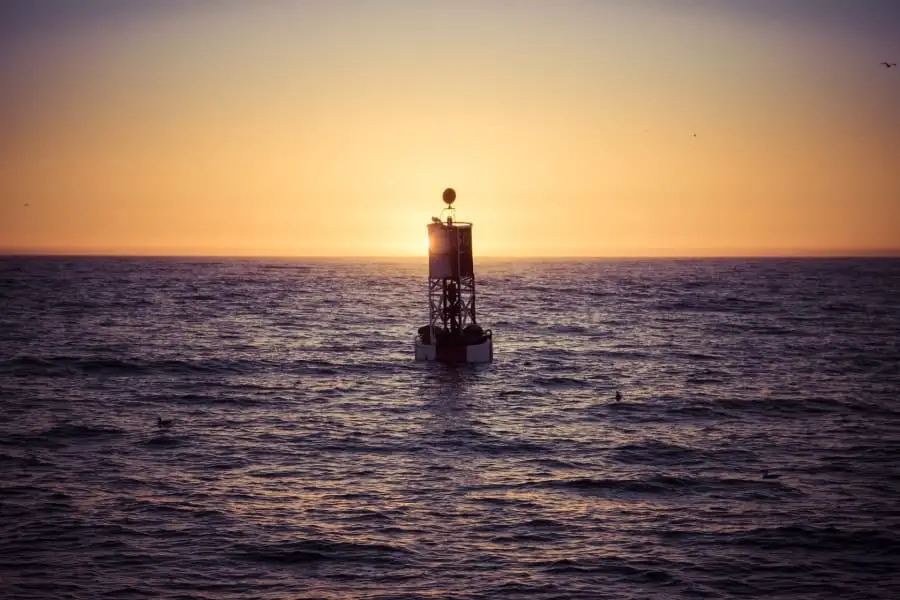
You might be wondering what all those lights, shapes, and sounds that are either attached to a vessel or emanating from them.
While it might not be obvious what these mysterious modes of communication mean, they play a very important role in ensuring the safety and proper communication between vessels and non-vessels alike.
Sailing safety has a lot to do with proper preparedness, which means having the right gear , plan, experience, and mindset. However, sailing safety also requires knowledge in the various forms of communication between vessels and non-vessels. This is where lights, shapes, and sounds play a big role.
By using various lights, shapes, and sounds when out on the water, vessels and non-vessels are able to communicate whether there’s danger afoot, they need help, or simply telling you to get out of the way.
We’ll explore the most common and vitally important light, shape, and sound signals to make sure you’re able to pick up and recognize them when the time is right.
Vessel Lights
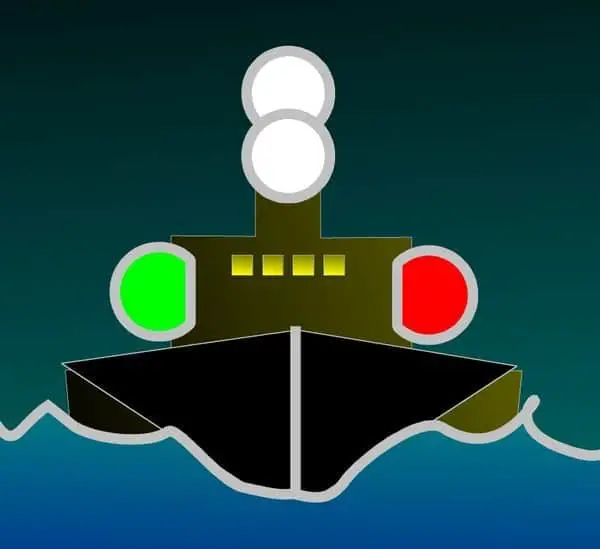
Whenever you see a vessel that has their lights on display, it’s most likely going to be during the evening when it matters most.
The combination of colors and how they’re oriented can mean a world of difference in terms of what they’re trying to communicate, so it’s important to keep an eye out.
The color of lights you’ll see when out on the water include white, red, green, and yellow. Again, you’ll see these on display at night when visual communication between vessels and non-vessels is crucial.
When you see lights on display, you’re essentially being told the vessel’s direction of movement, method of propulsion, and size.
Apart from the basic message of direction, propulsion method, and size, there are other light signals that are there to inform you of other situations. Some of those situations include when a vessel is
- Not under command
- Constrained by draft
- Unable to maneuver
The most important determination, when confronted with a vessel or non-vessel at night, is whether or not there’s a risk of collision.
Obviously, if there’s a risk of collision you need to attempt to communicate with the vessel immediately and to take proper action to avoid a collision. Ideally, you’ll be able to communicate with the other vessel so that you’re both in agreement about who does what to prevent a potential collision.
Basic Lights
As I mentioned previously, there are several basic colors that you’ll see on display from a vessel at night.
However, these lights can be displayed in different ways in terms of position on a vessel as well as how they’re displayed (e.g., blinking or static). Here are some basic definitions of lights that you should know.
Masthead Light
The masthead light is a static white light that sits partway up the main mast of a vessel and only displays to the front 225 degrees of the vessel.
This means that other vessels coming toward yours at an arc of 225 degrees will see an unbroken white light, which will inform them that you are possible head-on.
The sidelights are a pair of static lights that sit fore of the vessel at the bow with one being on the port side and the other on the starboard side.
The light on the port side is a static red light and the light on the starboard side is static green. The combination of both lights covers the same amount of arc as the masthead light, which is 225 degrees.
The sternlight is a static white light that sits as far back as possible aft the vessel at the stern and displays to the back 135 degrees of the vessel.
Other vessels who see this will know that they’re behind your vessel due to the light being lower than if they saw the masthead light and not being able to see the sidelights.
All-Round Light
The all-round light is a static white light that sits at the very top of a vessel’s mast and displays at a full 360-degree angle. You’ll see this light being displayed on a sailboat that’s either docked or at anchor.
Towing Light
The towing light is a static yellow light that sits at the same position as the sternlight and displays at an arc of 135 degrees aft the vessel. As the name suggests, this light indicates to other vessels that it’s currently towing an object.
Underway Vessels
When vessels are on the move and it’s dark out, there’s no doubt that being able to pick out fellow vessels is an important way to avoid any risk of collision .
In all likeliness, you’ll be able to pinpoint another vessel rather quickly at night be observing their lights and determine their position, direction of movement, and size.
Sailing Vessels
When spotting sailing vessels underway at night, you’ll be able to see at a bare minimum their sidelights and sternlight.
By observing which lights you can see and their orientation, you can quickly determine the position at which you’re viewing their vessel. However, depending on the size of the vessel, you’ll definitely see a different combination of lights.
If your vessel is less than 20 meters (65 feet) in length, then all you’ll need to display are the sidelights and sternlights when underway at night.
However, it’s also possible to display a similar set of lights in a different way indicating the same underway conditions, which is when you might see on the very top of the mast a 3-light combination — red, white, and green.
The 3-light combo displays at the same angles as the sidelights and sternlight. The only difference here is they’re situated at the top of the mast.
Sailing vessels underway that are larger than 20 meters will likely have a different set of lights on display, but the difference is huge.
With larger sailing vessels, you’ll still see the sidelights and sternlight with another pair of static lights near the top of the mast where the top light is red and the one below is green.
Power-Driven Vessels
Now, power-driven vessels are bit different when underway at night compared to sailing vessels. For one, a power-driven vessel can be as small or much larger than a sailing vessel, so the number of lights can vary quite a bit.
Also, a power-driven vessel is capable of much greater speeds than a sailing vessel, so ensuring other vessels are aware of their existence at night is very important.
Not unlike a sailing vessel, a power-driven vessel will also have a pair of sidelights and one sternlight. However, there’s an additional light that’s included in this combination and that being the white masthead light.
This 4-light combination will help other vessels like yours be aware that a 15 meter (50 feet) power-driven vessel is underway near them.
But what about the power-driven vessels that are well above the 15-meter size?
Well, the power-driven vessels that are much larger will have the same lights as the smaller power-driven vessel as well as a white static light at the bow that’s slightly lower in height than the masthead light.
This helps other vessels like yours get an idea of just how big this power-driven vessel really is.
Vessels At Anchor
Whenever you’re underway at night, there’s no doubt you want to be aware of other vessels underway to avoid a major collision .
But it’s also the case that you want to be able to spot those other vessels that are at anchor, especially if you’re moving around a marina or bay with other docked or anchored vessels.
Sailing vessels at anchor are very easy to pick out at night since all they need to have on display is their all-round light.
Remember that the all-round light is a static white light that provides a 360-degree view at the very top of a sailing vessels mast, so it’ll be quite difficult to miss. As a matter of fact, a power-driven vessel at anchor also has the same all-round light on display as long as it’s 50 meters (65 feet) or less in size.
For sailing and power-driven vessels that are greater than 50 meters in size, they have to put on display another all-round light.
However, this extra all-round light is placed near the stern of the vessel and is lower in height compared to the all-round light on the mast. This combination of all-round lights should tell you right away that you’re looking at a much larger vessel at anchor.
If you just so happen to see a vessel that’s greater than 100 meters (328 feet) in size and it’s also at anchor, you best believe you’ll see it lit up like a Christmas tree. When it comes to this size of a vessel, they’re required to put as many lights on display as possible.
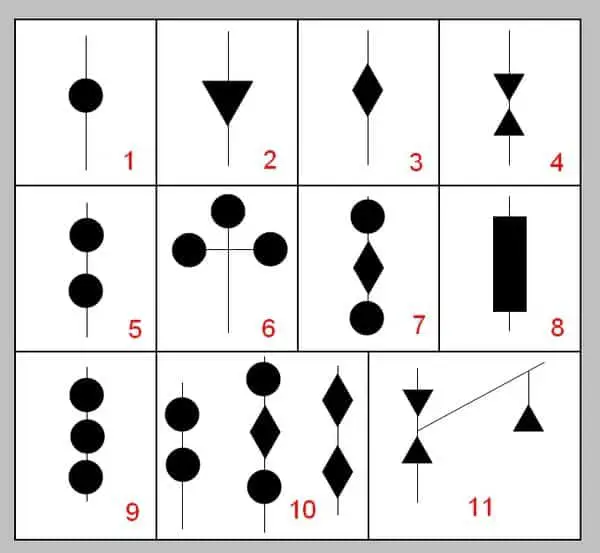
Most of what we’ve covered up to this point has been under the conditions of being underway or at anchor during the evening.
However, arguably more vessels will be out during the day than at night, so it’s important to be aware of other forms of visual communication such as day shapes.
During the day there’s little need for lights to communicate visually to other vessels, which is why we use shapes instead. There are a number of different shapes that take the form of circles, squares, triangles, and more that communicate different messages.
While there are a lot of different day shapes to consider, I want to cover the most common you’ll likely see while out on the water.
Being able to pinpoint a vessel, whether sailing or power-driven, that’s anchored during the day is rather straight forward as you should see a large black sphere hanging between the tip of the vessel’s mast to the fore of the vessel.
This single black sphere should be the size of a basketball and will be attached in the middle of a line.
Motoring and Sailing
If you’re out sailing and have your engine running to help boost your speed, you’ll need to ensure that you have a black, upside-down triangle attached to the middle of your forestay.
Just like the black sphere used to illustrate that your vessel is anchored, your sailboat should have the upside triangle in the same location. It’s important to note that this is only required for vessels that are 12 meters (39 feet) or greater in size.
Diving Operations
If you like to go freediving, scuba diving, or snorkeling, you’ll want to be sure to use the proper diving day shape.
Whether you’re on a small or medium sized vessel, make sure you put up the correct flag at the top of the mast. The most commonly used flag is blue and white while another flag is red with a white slash from one corner to another.
One of the worst situations you can find yourself or anyone else in while out sailing is ending up aground.
If this situation ever occurs, there should be three black spheres, just like the one you would use when anchored out, attached to the top of the mast in a vertical column. It’s important to note that this is only required for vessels that are 12 meters (39 feet) or greater in size.
Not Under Command
There will be times when vessels out on the water won’t be under command, which means you should be aware of this so you can make sure you can avoid them on your course.
Just like a vessel that’s run aground, you should see black spheres lined up vertically at the top of the mast, but instead of three spheres there should only be two. Again, this is only required for vessels that are 12 meters (39 feet) or greater in size.
Restricted Maneuverability
Some vessels can find themselves in situations that simply restrict their ability to maneuver, so being able to put that inability on full display to the rest of the vessels out on the water is rather important.
By putting a black, diamond-shaped object in between two black spheres in a vertical column at the top of the mast, this message is illustrated successfully. Similar to other day shapes, you’ll only find this on vessels that are 12 meters (or 39 feet) or greater in size.
Fishing and Trawling
Fishing is one of the oldest industries in the world and there’s no doubt that you’ll eventually find a vessel fishing and towing along a net.
Whenever a vessel is trawling, you should find two triangle shapes pointing at each other in a vertical column hoisted as high as possible.
There are also a few strange looking flags you’ll find being hoisted in the same location whenever a fishing vessel is either shooting nets, hauling nets, or their nets are caught on the seabed.
Buoys and Marks

Being able to safely navigate around other vessels out on the water is, of course, extremely important, but it’s also important to be observant of non-vessel objects that could get in your sailboat’s way.
Circumventing spots that are potentially dangerous comes first by being able to recognize the various buoys and marks on the water.
There are internationally agreed sets of buoys and marks that ensure safety for traveling vessels all over the world. Thanks to the International Association of Lighthouse Authorities (IALA), we have two major systems to abide by located in two different worldwide regions.
Fortunately, these two regions — Region A and B — have very few impactful differences. Region A (IALA A) covers all of Europe and pretty much the rest of the world while Region B (IALA B) covers the USA, Japan, The Philippines, and Korea.
Major Difference Between IALA A and IALA B
The major difference between the two regions is regarding the buoys which define which side of a channel the vessels should be traveling on.
For example, IALA B has red lights, marks, and/or buoys on the starboard (right) side of a channel when entering a place such as a harbor while under IALA A standards the red lights, marks, and/or buoys are on the port (left) side of a channel when entering.
These are known as lateral or channel marks and define the limits of the water that navigable across a channel.
Port and Starboard Marks
When it comes to buoys and marks that specify the port or starboard side of an object, the port side of an object is red and the starboard side of an object is green.
This is the same for when you’re sailing your boat when it comes to the foremost red and green lights on your vessel.
In regards to specific shapes of port and starboard marks, under the IALA B standards, port marks take the shape of a cone while the starboard marks take the shape of a can.
Safe Water Marks
A Safe Water Mark, also known as a Fairway buoy, is a red and white vertically striped object usually taking the shape of a sphere, pillar, or spar with a red ball on the top for the non-sphere shapes.
This mark usually indicates that you’re entering open and deep waters which should continue as you sail onwards.
Isolated Danger Marks
Having a mark named Isolated Danger Mark isn’t too comforting when you first read it, but it’s one of the most useful marks you’ll find. As the name implies, this mark indicates a location of potential hazard that should be avoided at all costs.
The Isolated Danger Mark should always be red and black horizontal bands with two black balls at the top. It should also have a flashing white light that comes in groups of two flashes.
Special Marks
A Special Mark can carry a number of different meanings, but it’s always displayed in the same way. Special Marks should be completely yellow and have an ‘X’ on the top of it.
A yellow flashing light is also found on the top of the Special Mark and can be seen quite distinctly at night. The reason you could find yourself near a Special Mark is due to it indicating
- Water skiing areas
- Anchorage areas
- Mooring areas
- Waiting areas
- Marine farms
- Historic wrecks
- Protected areas
- Sewerage pipes
- Submarine cables
Cardinal Buoyage System
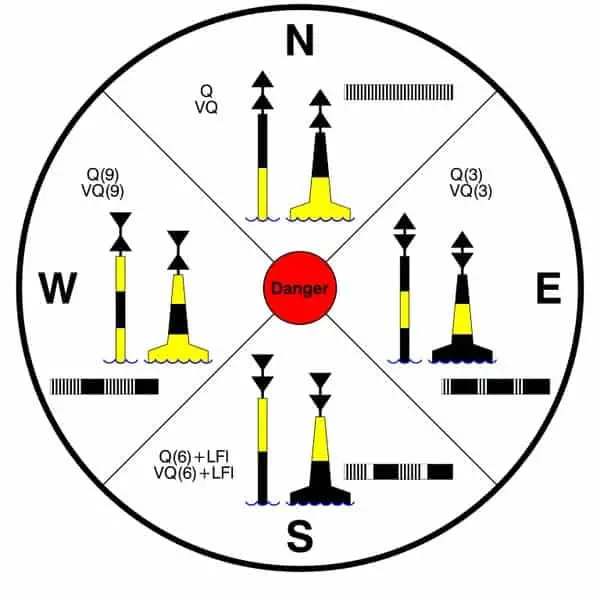
Another useful set of buoys is based on the Cardinal Buoyage System, which was designed to indicate the safe passage around a potentially hazardous area.
These Cardinal Marks are signaling to vessels that there’s an area that’s shallow, contains sunken objects, reefs, rocks, or something else.
By observing the Cardinal Marks, you’ll be able to tell where not to go based on their explicit placement. For example, if you see a North Cardinal Mark, your vessel can safely pass the hazard by traveling North of that marker.
The same goes for South, East, and West Cardinal Marks. Cardinal Marks are always black and yellow horizontally striped pillars.
The North Cardinal Mark is black on the top, yellow on the bottom, has two vertical triangles pointing up, and has a continuously flashing white light on the top.
The South Cardinal Mark is yellow on the top, black on the bottom, has two vertical triangles pointing down, and has a flashing white light on the top that flashes in groups of six followed by one long flash.
The East Cardinal Mark is black with a yellow stripe in the middle, has two vertical triangles pointing outward, and has a flashing white light on the top that flashes in groups of three.
The West Cardinal Mark is yellow with a black stripe in the middle, has two vertical triangles pointing inward, and has a flashing white light on the top that flashes in groups of nine.
Sound Signals
There may be times when you’re out sailing and the visibility is just too poor to be able to point out any buoys, flags, or shapes of any kind. Thankfully, we have light signals that can help us out when it comes to navigation around other vessels and potentially hazardous areas.
However, there may be times when we need to communicate more direct messages much more quickly. If VHF is not an option under these conditions, the use of sound signals is your go-to solution.
“You Are Running into Danger”
There are plenty of useful sound signals to be able to send out as well as recognize when the moment’s right, but there’s one that everyone should be aware of.
When someone yells “heads up!”, it’s likely you’re going to cover your head as soon as possible. When out on the water, the “heads up” can come in the form of two distinct sounds.
When someone is attempting to warn you that “you are running into danger” or you need to inform another vessel of this, you’ll need to know the Morse code word for ‘U’.
The word ‘U’ is presented as a one-second horn blast followed by a 4-6 second horn blast. You can think of this as a short blast followed by a long blast.
In all likeliness, you’ll be the one hearing this sound signal as opposed to you sending it out. Most of the time when this sound signal is used, it’s coming from much larger vessels such as oil rigs, cruise ships, and other vessels of similar size.
Poor Visibility Sound Signals
There are a few sound signals that you should keep in mind when visibility becomes poor while out on the water. Some of the most important include:
- Power underway, making way: one 4-6 second blast and a 2-minute wait.
- Power underway, not making way: two 4-6 second blasts and a 2-minute wait.
- V essel sailing, fishing, not under command, towing, maneuverability restricted: one 4-6 second blast, two 1 second blasts, and a 2-minute wait.
- Last manned vessel of tow: one 4-6 second blast, three 1 second blasts, and a 2-minute wait.
- Warning from vessel at anchor: one 1 second blast, one 4-6 second blast, and one 1 second blast.
- Plot vessel on duty: four 1 second blasts.
- Vessel at anchor: 5 seconds of rapid bell ringing and a 1-minute wait.
- Vessel aground: 3 short bell rings, 5 seconds of rapid bell ringing, and 3 short bell rings.
Maneuvering and Warning Sound Signals
If you ever find yourself communicating with another vessel using sound signals, you’ll definitely need to confirm with one another who’s going to do what so as to avoid the risk of a collision.
Here are some of the most important sound signals you can use to communicate with other vessels.
- I’m altering course to starboard: one 1 second blast.
- I’m altering course to port: two 1 second blasts.
- I’m operating stern propulsion: three 1 second blasts.
- I don’t understand your intentions! I doubt you’re taking sufficient action to avoid collision: five or more 1-second blasts.
- I intend to overtake on your starboard side: two 4-6 second blasts and one 1 second blast.
- I intend to overtake on your port side: two 4-6 second blasts and two 1 second blasts.
- Agreement by overtaken vessel: one 4-6 second blast, one 1 second blast, one 4-6 second blast, and one 1 second blast.
- Approaching blind bend in channel: one 4-6 second blast.
- Reply from vessel on other side of bend: one 4-6 second blast.
Get the very best sailing stuff straight to your inbox
Nomadic sailing.
At Nomadic Sailing, we're all about helping the community learn all there is to know about sailing. From learning how to sail to popular and lesser-known destinations to essential sailing gear and more.
Quick Links
Business address.
1200 Fourth Street #1141 Key West, FL 33040 United States
Copyright © 2024 Nomadic Sailing. All rights reserved. Nomadic Sailing is a participant in the Amazon Services LLC Associates Program, an affiliate advertising program designed to provide a means to earn fees by linking to Amazon.com and affiliated sites.

- CLASSIFIEDS
- NEWSLETTERS
- SUBMIT NEWS
The Best Lopolight Navigation Lights for Sailboats from 12 to 20 Meters
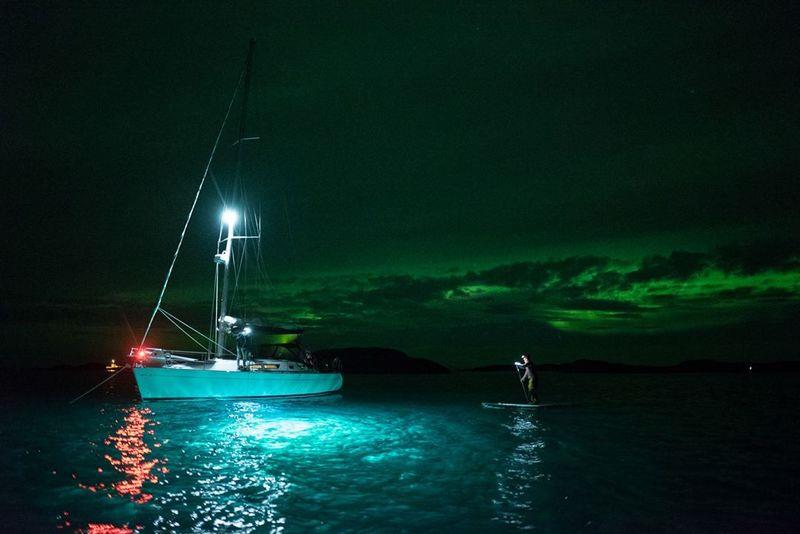
Related Articles
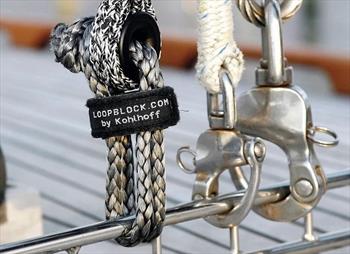
- New Sailboats
- Sailboats 21-30ft
- Sailboats 31-35ft
- Sailboats 36-40ft
- Sailboats Over 40ft
- Sailboats Under 21feet
- used_sailboats
- Apps and Computer Programs
- Communications
- Fishfinders
- Handheld Electronics
- Plotters MFDS Rradar
- Wind, Speed & Depth Instruments
- Anchoring Mooring
- Running Rigging
- Sails Canvas
- Standing Rigging
- Diesel Engines
- Off Grid Energy
- Cleaning Waxing
- DIY Projects
- Repair, Tools & Materials
- Spare Parts
- Tools & Gadgets
- Cabin Comfort
- Ventilation
- Footwear Apparel
- Foul Weather Gear
- Mailport & PS Advisor
- Inside Practical Sailor Blog
- Activate My Web Access
- Reset Password
- Pay My Bill
- Customer Service

- Free Newsletter
- Give a Gift

How to Sell Your Boat

Cal 2-46: A Venerable Lapworth Design Brought Up to Date

Rhumb Lines: Show Highlights from Annapolis

Open Transom Pros and Cons

Leaping Into Lithium

The Importance of Sea State in Weather Planning

Do-it-yourself Electrical System Survey and Inspection

Install a Standalone Sounder Without Drilling

When Should We Retire Dyneema Stays and Running Rigging?

Rethinking MOB Prevention

Top-notch Wind Indicators

The Everlasting Multihull Trampoline

How Dangerous is Your Shore Power?

DIY survey of boat solar and wind turbine systems

What’s Involved in Setting Up a Lithium Battery System?

The Scraper-only Approach to Bottom Paint Removal

Can You Recoat Dyneema?

Gonytia Hot Knife Proves its Mettle

Where Winches Dare to Go

The Day Sailor’s First-Aid Kit

Choosing and Securing Seat Cushions

Cockpit Drains on Race Boats

Rhumb Lines: Livin’ the Wharf Rat Life

Re-sealing the Seams on Waterproof Fabrics

Safer Sailing: Add Leg Loops to Your Harness

Waxing and Polishing Your Boat

Reducing Engine Room Noise

Tricks and Tips to Forming Do-it-yourself Rigging Terminals

Marine Toilet Maintenance Tips

Learning to Live with Plastic Boat Bits
- Safety & Seamanship
RAM Lights for Sailboats
A search for a brighter anchor light yields a versatile surprise..
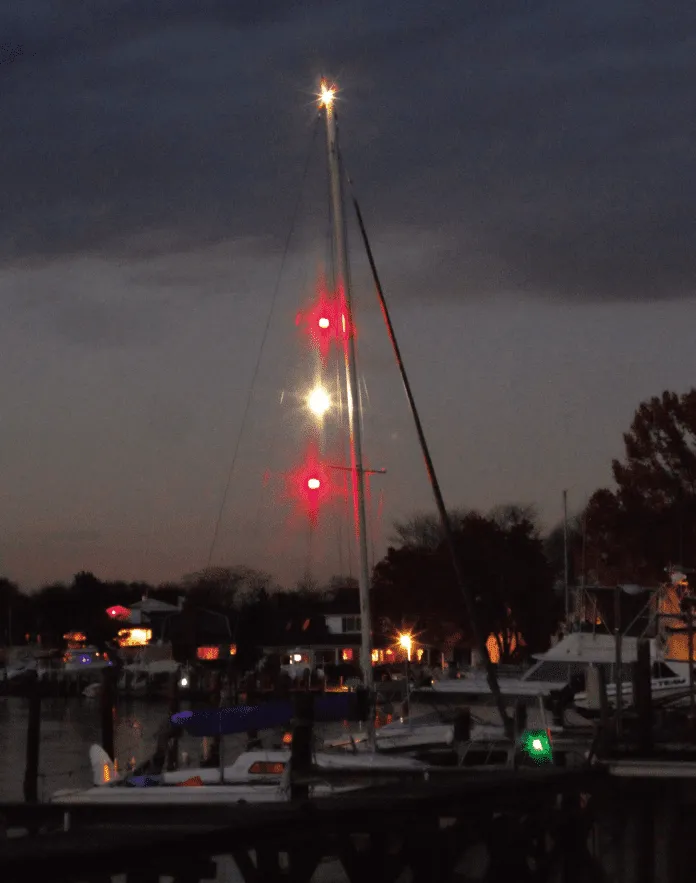
We have the minimum required lights, including running lights for sailing and motoring, and an anchor light. We might even have an electronic distress signal (“ Distress Flares Go Electric, ” June 2021). But do we have lights for rare navigation lighting situations, such as restricted ability to maneuver (RAM) or not under command (NUC)?
Ships, fishing boats, tugs, and dive boats are just some of the vessels that have masts dedicated for lights to alert nearby ships of their status, and to signal situations that might prevent them from maneuvering to avoid collision. Relatively few sailors have a means of showing all the specialized lights that might apply to sailboats. Should we?
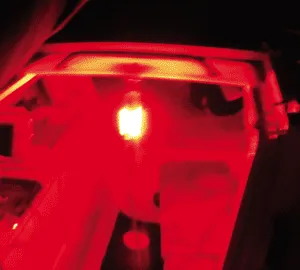
An anchor light is not for drifting, using a sea anchor, or any situation where you are not made fast to the ground. Flashing lights are only for distress. Thus, lighting and day shapes for a few additional navigation situations deserve discussion.
RESTRICTED ABILITY TO MANEUVER (RAM)
The lights for this situation are a vertical row of three lights, red/white/red, spaced 1 meter apart. The day signal is a ball/diamond/ball. RAM suggests that the motion of the boat will be predictable. A boat with divers in the water, hove to, or towing a drogue would be considered a RAM.
NOT UNDER COMMAND (NUC) DAY SHAPES AND LIGHTS
A vertical row of two red lights indicates the skipper has no control over motion, perhaps because of a broken rudder. Any motion, including drifting, qualifies as NUC. The day signal is two balls.
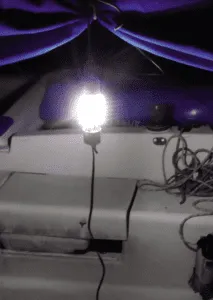
A day flag (either the blue and white “alpha” flag, or red with white diagonal stripe in the US) is required by law or regulation in the US and many countries. The divers are to stay within 25 yards (varies by state) when near the surface and boaters are to stay 300 yards from the flag (100 yards in a marked channel). No divers? Take the flag down. (Some states permit a flag painted on the side of dive boats).
At night a dive boat is considered restricted in its ability to maneuver (RAM), and the required lights are red/white/red, one meter apart in a vertical line. If the boat is drifting, running lights are also required, and if anchored, an anchor light is still required.
SEA ANCHOR OR DROGUE
Just like a dive boat that is drifting, a boat dragging a sea anchor or drogue needs to show running lights and RAM lights. Running with a drogue in heavy weather can be a matter of speed control and easing the motion, or survival. In the first case your ability to change course is limited, and you have very little control over the vessel’s speed. In the latter case you have no control over speed or course, but the motion of your vessel will be predictable.
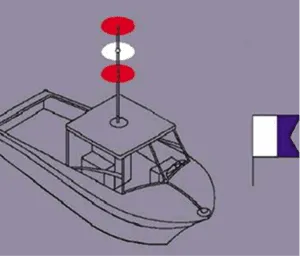
PROPER USE OF NUC INDICATORS
A boat with steering failure, dismasting, or some other situation that makes it impossible to control is considered not under command (NUC). A rudderless boat may randomly tack, circle, or speed up and slow down. Its motion is unpredictable. The day shapes and lights for this situation are not for sleeping or leaving watch, only for a boat that cannot be controlled.
COLREGS AND LIGHTS
A discussion of the Collision Regulations (COLREGs) regarding the above situations is best carried out with the rules at hand. The Coast Guard version, which includes U.S. inland rules as well as international rules, is available online ( www.navcen.uscg.gov/pdf/navrules/navrules.pdf ). Here are just a few excerpts relevant to lights and shapes for sailboats.
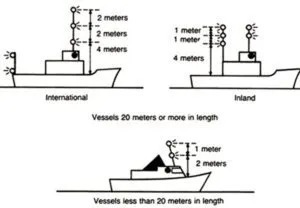
WHAT IS RESTRICTED ABILITY TO MANEUVER?
Definitions for a boat that is restricted in its ability to maneuver are in Rule 3 of the COLREGs.
(g)The term vessel restricted in her ability to maneuver means a vessel which from the nature of her work is restricted in her ability to maneuver as required by these Rules and is therefore unable to keep out of the way of another vessel. The term vessels restricted in their ability to maneuver shall include but not be limited to: (i)a vessel engaged in laying, servicing or picking up a navigation mark, submarine cable or pipeline; (ii)a vessel engaged in dredging, surveying or underwater operations; (iii)a vessel engaged in replenishment or transferring persons, provisions or cargo while underway; (iv)a vessel engaged in the launching or recovery of aircraft; (v)a vessel engaged in mine clearance operations; (vi)a vessel engaged in a towing operation such as severely restricts the towing vessel and her tow in their ability to deviate from their course.
SLEEPING UNDER SAIL OR UNDER BARE POLES
An unattended helm is not allowed under COLREGs. This is spelled out in Rule 5.
Every vessel shall at all times maintain a proper look-out by sight and hearing as well as by all available means appropriate in the prevailing circumstances and conditions.
Rule 37 covers distress signals.
When a vessel is in distress and requires assistance it shall use or exhibit the signals described in Annex IV of these Rules (33 CFR part 8) to illuminate her decks.
The accepted signal is a strobe flashing 50-70 times per minute. Sailors should also review also Rule 36, which states that any light used to attract the attention of another vessel cannot be mistaken for any aid to navigation. The rule also advises that the use of high intensity intermittent or revolving lights shall be avoided.
VERTICAL SPACING
Vertical spacing of lights is covered in Annex I. For boats less than 20 meters in length, the vertical row of lights must be greater than 2 meters above the uppermost continuous deck, spaced one meter apart, and be visible in all directions (no more than 6 degrees may be blocked by mast). For boats greater than 20 meters, the lights must be 4 meters above the deck and the spacing must be 2 meters (see illustration 2, page 18).
EXTRA LIGHTS
Rule 30 deals with extra lights in subsection (c):
A vessel at anchor may, and a vessel of 100 meters and more in length shall, also use the available working or equivalent lights to illuminate decks.”
FLORIDA DIVER LAW
Florida gets specific regarding divers. Not only are lights required at night, but a flag must be displayed. Interestingly, the specified flag differs from the international flag, which is the blue and white “Alpha” signal flag. According to Section 327.331 of Florida code:
(c) “Divers-down flag” means a flag that meets the following specifications:
1. The flag must be square or rectangular. If rectangular, the length must not be less than the height, or more than 25 percent longer than the height. The flag must have a wire or other stiffener to hold it fully unfurled and extended in the absence of a wind or breeze.
2. The flag must be red with a white diagonal stripe that begins at the top staff-side of the flag and extends diagonally to the lower opposite corner. The width of the stripe must be 25 percent of the height of the flag.
3. The minimum size for any divers-down flag displayed on a buoy or float towed by the diver is 12 inches by 12 inches. The minimum size for any divers-down flag displayed from a vessel or structure is 20 inches by 24 inches.
4. Any divers-down flag displayed from a vessel must be displayed from the highest point of the vessel or such other location which provides that the visibility of the divers-down flag is not obstructed in any direction.
(2) All divers must prominently display a divers-down flag in the area in which the diving occurs, other than when diving in an area customarily used for swimming only.
A black ball displayed where it is visible during they day indicates that a boat is at anchor. Use of this day shape for anchoring varies with the region, but in most of the U.S. no one uses them, few look for them, and most wouldn’t recognize it for what it is. Rules for smaller boats vary. In the U.S., boats less than 7 meters are exempt. Nevertheless, displaying a black ball makes sense near channels, so ships to determine your navigation status (anchored vs. underway) at a great distance. COLREGS specifies a ball with a minimum diameter of 2 feet, with exceptions.
For vessels of less than 20 meters in length, shapes of lesser dimensions but commensurate with the size of the vessel may be used, and the distance apart may be correspondingly reduced.
CONCLUSIONS
If you carry a sea anchor or drogue, have ever considered diving at night, or embark on single-handed voyages, making yourself both more visible and communicating your navigation status is smart. We don’t understand why hoistable light systems for recreational boaters is not available, so we’ve offered some do-it-yourself ideas in this report.
When it comes to lights for special situations like night diving or when the boat is disabled, recreational boats need temporary options that cost less and require little power. We found nothing practical that met our basic criteria for contingency use on sailboats. If you know of one, you can email us at [email protected] . These are all the lights that we found:
AQUASIGNAL HOISTABLE LIGHT
Aquasignal Series 40 hoistable lights. Similar to standard series 40 lights, these are 8 inches tall, 3 inches in diameter, and fit 25W incandescent bulbs (no LED option). Rigged as a red/white/red RAM light, they use 75 Ah of power each night, an unacceptable amount for many cruising boats. The cost is also steep, at $120 each ($360 total).
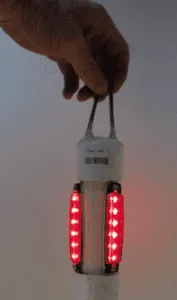

PERKO HALYARD MOUNT
The Perko halyard mount navigation lights are similar to the Aqua Signal lights, but they are discontinued, and we found no replacement. They cost about $85 ten years ago.
PRACTICAL SAILOR DIY LIGHT
Our DIY RAM light is based on the DIY anchor light modules but substituting red LEDs for white. They are weather proof, vibration resistant, meet the Coast Guard requirement for 3 mile visibility, and because the lights have a 120-degree vertical arc of visibility, full visibility is maintained even as a boat rolls heavily. The red version is slightly less bright than the white version, though it still meets the standard. You could, of course, mount four LED strips to make the red version brighter; there is enough room.
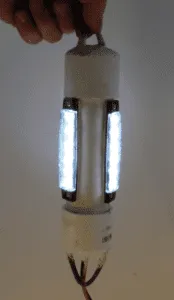
We considered adding switches, allowing a single unit to show a single white (anchor), red/white/red (restricted ability to maneuver) or two red (not under command), but decided that introduced additional failure points for options that would very seldom be used. Instead, we made the system modular, and you hoist only the components you need. They are chained together with cord/line extensions as needed. The cord/line extension is a 30-inch Dyneema strop with an eye in each end (one-meter spacing is required, and the light units are 10 inches long). Cable ties firmly attach a 24-inch 2-pin extension cord. One end of the strop is secured with a luggage tag hitch and the other with a screw link or shackle.
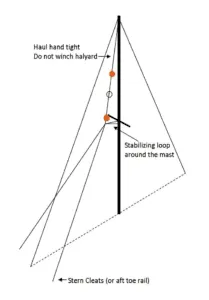
Our design for a DIY anchor light/RAM light is based on three white LED road trailer clearance marker lights, available for less than $1.50 per unit when purchased in packs. They meet the visibility requirements for boats of all sizes because they are designed to meet EU and US truck clearance light brightness requirements, which are significantly greater than those required for navigation lights. They are low-profile, weatherproof, and resistant to impact and vibration.
We mounted the lights around an 8-inch length of 1 ¼-inch PVC pipe; a single 5/16-inch hole passes the wires, two screws attach it in place, and it is sealed in place with a generous application of polyurethane caulk (we used Sika 291). The leads are coupled to a common 12V SAE 2-pin extension cord. Remember, LEDs are sensitive to polarity, so keep the positive and negative straight and used polarized plug connectors. The current draw is low enough (0.09 amps or 2.2 Ah per 24 hours) that we skipped the photo-electric cell that would turn it on and off automatically.
STEP BY STEP
1. Cut 6 ½-inch length of 1 ¼-inch schedule 40 PVC pipe.
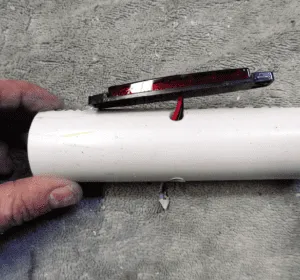
2. Drill three x 5/16-inch holes in the side for the light’s wires (Photo 1). Fit should not be too tight—you don’t want to pinch the wires. The holes are centered between the ends and spaced around the pipe 120 degrees apart. An easy way to mark for drilling is to wrap a sheet of paper around the pipe and cut at exactly one circumference length. Fold the paper into thirds, mark the folds, and wrap again. The folds will be 120 degrees apart and in line vertically, ready for marking
3. Drill holes for the mounting screws. Machine screws about ½-inch long are preferred; they won’t stick in far and they won’t cut the wire insulation. No need for nuts. Just drill holes 1/64-inch smaller than your screws, and they will self tap in the soft plastic.
4. Insert the wires through the center holes, apply sealant around each hole and down the center of the light strip, and screw them down. It is tempting to apply the sealant first, but then inserting the wires is a mess.
5. Wipe up the excess sealant. It’s a mess. You could mask around the holes for a neater finish.
6. Prepare the top cap (white anchor light-only). Drill two 3/16-inch holes in the cap, insert 10 inches of 3/16-inch Dyneema to form a loop, securing the ends with stopper knots. Apply sealant inside and out.
7. Prepare bottom cap and top cap of RAM modules. Same as Step 6, but add about 5/16-inch to center hole, to accommodate the plug pigtail.
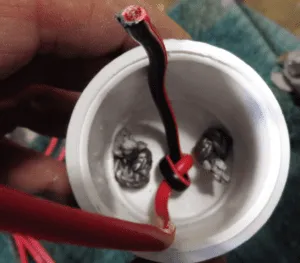
8. Thread the plug pigtails through the bottom cap hole and knot inside (Photo 2).
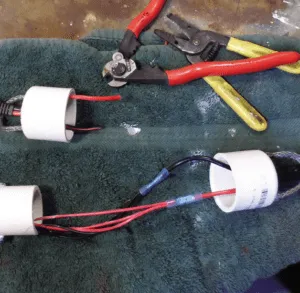
9. Twist the leads together and crimp to the pigtails (Photo 3). Be sure to strip enough insulation to allow for several twists. LEDs are polarity sensitive, so connect black-to-black (Photo 4). Seal the union with adhesive-lined heat shrink. Good fittings will have enough adhesive to fill the gaps between the three leads. The three leads, twisted together, should be about 14-16 AWG. RAM modules should have double-plug leads, one through the top and one through the bottom, so that they can be chained together.
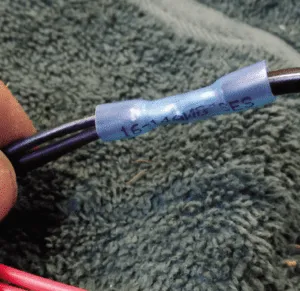
10. Note that although all 2-pin plugs appear identical, there is a distinct male and female. The male plug has the ground (black) exposed, so that accidental contact with a grounded surface, like a mast or engine, does not cause a short. Each light module must contain either a female plug (anchor light only) or one of each (RAM modules), so they can be chained together. Mark each module with an up arrow, or you will be frustrated when you plug in the wrong end and it doesn’t light.
11. Seal the Dyneema line and the pigtail into the bottom cap, inside and out.
12. Glue on both end caps on with PVC cement. The tensile strength of each unit exceeds 1,000 pounds (we tested them), so a string can safely be hauled as tight as hand tension allows.
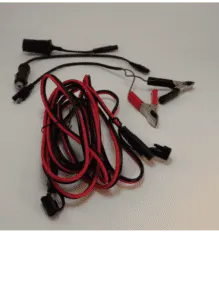
13. Prepare the supply cord. For the emergency anchor light we chose an 8-foot extension cord with SAE 2-pin connectors. We have three convenient outlets for this connector. We can plug it in just in front of the mast, in the cockpit, or in the cabin. In a pinch, you can rig a fused lighter plug directly to a battery (Photo 5), but lighter plugs are notoriously unreliable on boats, so this is temporary. As a supplemental harbor anchor light, we hoist the light 6 feet above the deck; at this level it is visible to nighttime dinghy operators and also lights up the deck. We can also extend with standard 2-pin extension cords. If the light is to be used as part of a RAM light system, the cord is shortened to 6 inches, so that it can be used as a module. Red light modules are the same as the anchor light module, except red LED marker lights are used.
14. Rig using non-stretch line (a halyard is good for the top) to reduce swinging. In wild weather, reduce swing by rigging the bottom line as a bridle that secures to the port and starboard toe rails (see Image 4). To prevent fore-aft swinging, add a loop (about 30 inches long) attached to the bottom light and around the mast, and raised to a point just below the spreaders. The bridles should be led aft and outboard. The lights must be pulled several feet away from the mast to keep the blind spot less than 6 degrees. The lights will hang at a slight angle, but this is not a big deal. In our case, the mast is raked sufficiently to serve this purpose. There is no need to pull the lights to the masthead, although they should be high enough to be visible above the swell.
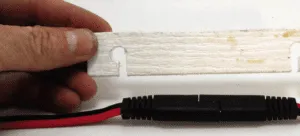
15. Prepare cord locks, if desired (Photo 6). The SAE plugs were designed for trailer wiring and the high friction fit is very unlikely to pull apart. But you can add locks for more security, and they take only a few minutes to make. The holes in the locks are 1/16-inch larger than the widest cord diameter. The slot is just wide enough to pass the narrowest dimension. The spacing is about 3/8-inch longer than the length of the closed plug pair. The strip can be either 3/16-inch HDPE or 1/8-inch aluminum, or fiberglass. It’s width is about 1 inch (aluminum or fiberglass) or 1 1/4-inches (high density polyethylene). Smooth the edges to avoid damaging the wire insulation.
The white light makes a useful cockpit and bilge work light. It’s waterproof. The red lights can be hung in the cabin or cockpit for vision-safe night lighting, although you still don’t want to look directly at the light (see “ Are Chart Lights Steering Us Wrong ,” PS October 2020).
Caps. $ 2 x 1.57 = $3.14
6.5” pipe = $0.70
LEDs = Three white side marker lights (6 LEDs each), 3 x $2.12 = $6.36
Assorted wire and sealant = $4
Cord = $4.20
Rope = $0.40
Total = $18.80
Since our August 2021 review of deck connectors (“ Watertight Connector Test ”), we’ve converted our F-24 test boat to SAE 2-pin connectors for many applications, including tiller pilot, mast lights, and utility cockpit connections. We like the price and widespread availability of the components, but the big selling point is easy interchangeability and ruggedness. For example, we can plug the emergency anchor lights and RAM lights into the mast base plug, the tiller pilot plug, a cabin plug, the cockpit plug, or straight to the battery with clips. Same with our utility washdown/emergency sump pump; we can plug it in wherever needed, just like appliances at home.
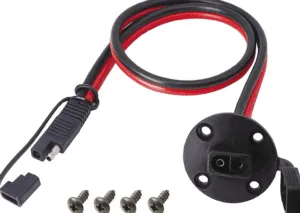
All of this applies equally to 4-pin connectors. They can be the better answer if you need more power to control more things. We’ve used 4-pin connectors for connections at the mast base for trailer boats.
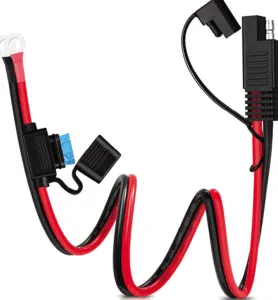
The exposed pin should be ground phase to reduce the risk of shorts. As long as the exposed pin is ground and the adjacent pin is power, 2-pin plugs can also be inserted into 4-pin sockets. Grease exposed ends with Tefgel or Green Grease twice per year (every few years inside the cabin). Keep the caps on when not in use so they don’t attract dirt and to cover the ground pin.
You will have to splice the wire tails. Crimping and heat shrink is preferred below deck. Soldering and adhesive lined heat shrink yields a more streamlined result and is acceptable for above-deck cords.
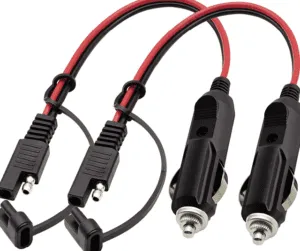
We like the broad deck mounting flange. We like the molded seal. Between these two factors, they absolutely cannot leak through the deck. Most have tinned wire, and because they are used for motorbike charging, the wire is typically at least 14 AWG.
Maintain polarity. If you are careful with your wiring you’ll ensure correct polarity.
We have used these SAE connectors on a Stilleto 27 for 8-10 years with no problems, while multiple brands of “marine-grade” connectors failed.
The COLREGs allows two lighting schemes for sailboats; either red and green side lights plus a stern light, or a single tricolor mounted at the top of the mast. The advantage of the tricolor is that it can be seen above waves. However, like a masthead anchor light, it is hard to see at close range. Also you can’t use a tricolor when motoring, since your white steaming light indicating a power-driven vessel must be above the side lights.
A less commonly seen combination is for sailing boats is red over green, one meter apart, at or near the top of the mast. This is in addition to the usual side lights farther down and the white stern light. Advantages of this setup are increased visibility in waves, visibility in close quarters, and unlike the other options, a means of estimating distance, since more than one light is visible at a time.
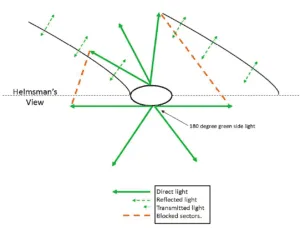
It is widely believed that the red-over-green light is for sailboats longer than 20 meters, but in fact there is no size restriction. A tricolor cannot be used by boats over 20 meters, and so red-over–green makes sense for them at sea. Ideally, the lights are above the mast and unobstructed in all directions. A one meter mast light could also be attached to the top of the mast; it won’t increase the air draft by one meter, since the VHF aerial is probably more than half that.
However, the USCG COLREGS manual clearly shows the green light some distance down the mast, where it will be blocked in some directions by the mast and sails. Green light will also reflect off the sails, which can be annoying. Commonly, instead of a single green light, 180-degree green side lights are mounted on each side of the mast, 1-meter down, with a red light at the masthead.
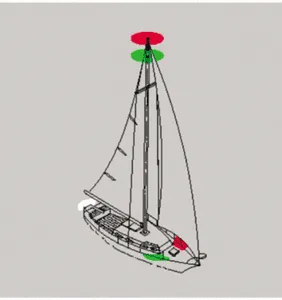
This requires one more pair of lights, but no more cabling than a tricolor. However, a hoistable red-over-green modular light like the one described in the adjacent articles could be used when more visibility is desired.
A paper recently submitted to World Sailing lays out the problems sailboats face trying to comply with the COLREGs ( http://honeynav.com/wp-content/uploads/2020/04/OC4biNavigationLightReportVerFinal-25596.pdf ).
RELATED ARTICLES MORE FROM AUTHOR

How Can I Keep My Kids Safe Onboard?
Sailboats under no circumstance are under the category of ram. They are not restricted of maneuver. No need for this
Where did you get this idea? Sailing vessels had in the past performed many of the tasks in Colregs Rule 3(g) and most are also auxillary power driven vessels. They can, for instance, engage in emergency towing and are then very much in a RAM condition. Bering Sea Gold had a sailboat involved in dredging (and diving!). The same lights are used for diving. People don’t dive off sailboats? That’s news. Sailboats can be aground, and then should display two red all around lights. Just omit the white in between.
Which case do you disagree with and why? Diving at night (COLREGS rule 27ei and state law)? Lying to a drogue (steering is greatly restricted and in survival conditions releasing the drogue is not an option)?
Sail or power is not a factor in these determinations. Very likely the sailboat has no sail up and is a power driven boat for the purposes of COLREGS.
LEAVE A REPLY Cancel reply
Log in to leave a comment
Latest Videos

Island Packet 370: What You Should Know | Boat Review

How To Make Starlink Better On Your Boat | Interview

Catalina 380: What You Should Know | Boat Review
- Privacy Policy
- Do Not Sell My Personal Information
- Online Account Activation
- Privacy Manager
MORE SECTIONS
- Social Casino
MORE FROM THE SUN
- Newsletters

Drivers are just realizing what ‘blue sailboat’ icon means in winter – it may not be safe to drive yet when you see it
- Kristen Brown
- Published : 12:11 ET, Oct 28 2023
- Updated : 12:11 ET, Oct 28 2023
AUTOMOTIVE experts have warned drivers of the true meaning behind the 'little blue sailboat' dash light.
As winter slowly creeps up and temperatures go down, it's important to know that certain temperature-related lights mean, and how to respond to them.

A car review channel on TikTok called Basic A*s Car Reviews (@ basicasscarreviews ) uploaded a humor laden video telling drivers that the 'little blue sailboat' is warning drivers their car is too cold.
"Listen up psychos," she said.
"You don't just hop in the car and drive off, you have to wait until the car warms up, especially in the winter. That's what this little blue sail boat is for."
She zooms in on her dashboard, which showed the bright blue thermometer light floating in liquid, which some have nicknamed the "little blue sail boat."
Read More on Dash Lights

Dashboard warning light should alarm drivers - pull over & get it checked

I’m a mechanic - how to stop dashboard warning light which won't turn off
"Once the car is heated and the blue sail boat is gone, then you can go," she said.
According to The Auto Doc , that light simply indicates that the temperature of the vehicle's coolant is below the recommended temperature.
"In fact, the temperature is so low that it is possible for your radiator to get too cold, thus resulting in your engine freezing up and not being able to start," the site reads.
However, as long as a vehicle's coolant is changed upon manufacturer suggested intervals and there are no leaks, coolant will never freeze, but it can become more viscous.
Most read in Motors

Drivers fume over Biden's new plan to push out gas for electric vehicles

Driving crackdown takes effect March 21 after 'warning period' with new $50 fine

Gas cars to be phased out by 2032 under new Biden admin ruling in huge EV push

My neighbor 'loves' to block my driveway - but some think I shouldn't be mad
"But for this light to come on right at startup is normal. If anything, it's simply telling you that you just need to let your engine warm up a bit... The light will go away within a minute or two."
Though the warm up topic is wildly debated in the automotive industry, with some experts like The Auto Doc saying warming up an engine for a minute or two is a must, while others say modern tech renders the practice unnecessary.
J.D. Power states that warming up a vehicle for more than 20 to 30 seconds can be considered wasteful, especially with modern cars.
"Before the mid-90s, most vehicles used a carburetor, a mechanism that blends air and fuel for internal combustion engines in a suitable air-to-fuel ratio," the site reads.
"But during the late-80s and 90s, American car manufacturers began switching to fuel-injected engines."
With modern tech being so refined, idling for longer is an unnecessary waste of fuel and yields no real benefits for the engine.
"Warming up is a great way to maintain engine health . You allow it to lubricate itself and, in turn, prolong its life cycle. However, modern vehicles no longer have carburetors, and lubrication takes 20-30 seconds," the site says.
"So, there is no real need to sit idle much beyond the time it takes to defog the windshield."
- Car Maintenance
Steaming Light on Sailboat: A Guide to Proper Usage
by Emma Sullivan | Aug 11, 2023 | Sailboat Maintenance

== Short answer: Steaming light on sailboat == A steaming light is a white navigation light fitted on the mast of a sailboat to provide visibility during low-visibility conditions. It is typically placed near the front side of the mast and angled downwards to indicate that the vessel is under power and moving forward. This light helps other boats identify and avoid collisions, ensuring safe navigation at night or in limited visibility situations.
Understanding the Purpose of a Steaming Light on a Sailboat: What You Need to Know
Have you ever been out on a sailboat and noticed a small light at the top of the mast? You might have wondered what its purpose is or why it’s necessary. Well, that little light is called a steaming light, and it plays a crucial role in ensuring safety and navigation on a sailboat . In this blog post, we will dive into the details of understanding the purpose of a steaming light on a sailboat.
To begin with, let’s clarify what exactly a steaming light is. A steaming light is a white-colored navigation light located on the front of the mast or near the bow of a sailboat. Its main function is to provide visibility to other vessels during low-light conditions or at night. This means that whether you’re sailing in foggy weather, dim lighting, or after sunset when natural visibility decreases, the steaming light will maximize your boat’s presence to prevent collisions with other boats.
So why is it specifically called a “steaming” light? The term “steaming” refers to sailing when using an engine rather than relying solely on wind power. When you are using your boat’s engine for propulsion instead of sailing with just your sails, it is known as “motoring” or “steaming.” The steaming light got its name because it primarily signifies that the vessel has powered propulsion engaged rather than utilizing only wind power.
Now that we know what a steaming light does and where it gets its name from let’s discuss more about its importance. One major reason for having this navigation aid onboard is compliance with international boating regulations and standards set by organizations like COLREGs (Convention on the International Regulations for Preventing Collisions at Sea). These regulations ensure safe navigation practices globally and require boats to display certain lights for visibility purposes both to avoid accidents and allow other captains to understand their intentions.
When operating under engine power, displaying only proper red (port) and green (starboard) sidelights can confuse other boaters, as these lights typically indicate the presence of a vessel under sail. To avoid such confusion, the use of a steaming light in conjunction with the appropriate sidelights clarifies that the boat is motoring and not just relying on its sails for propulsion.
Another important aspect to note about steaming lights is their distinct positioning on a sailboat . Typically, they are mounted at least one meter above the deck level to ensure maximum visibility. This height allows for unobstructed illumination, making it easier for other boaters to see your vessel from afar. It’s crucial to maintain this specific positioning to comply with regulations and maximize safety on the water.
In summary, understanding the purpose of a steaming light on a sailboat is essential for any sailor or boat owner. Its primary function is to provide visibility during low-light conditions or at night when using engine power instead of relying solely on wind power. By complying with international regulations and properly displaying navigation lights like a steaming light , you enhance safety by avoiding confusion between sailing and motoring vessels. So next time you’re out on the water after dusk or in foggy weather, remember the importance of that little but mighty steaming light atop your sailboat’s mast!
Step-by-Step Guide: How to Install a Steaming Light on Your Sailboat
Installing a steaming light on your sailboat might seem like a daunting task, but with the right guidance and a bit of patience, you’ll have it up and running in no time. In this step-by-step guide, we’ll walk you through the process of installing a steaming light on your sailboat, ensuring that you have a safe and well-lit vessel on your next sailing adventure.
Step 1: Gather the necessary tools and materials Before diving into the installation process, make sure you have all the tools and materials required. You’ll need a steaming light fixture, wires (preferably marine-grade), heat shrink tubing, electrical connectors, wire cutters/strippers, crimping tool, electrical tape, screwdrivers (flathead and Phillips-head), mounting brackets or screws if needed, and a drill with appropriate bits.
Step 2: Identify the ideal location for installation Finding the right spot for your steaming light is crucial as it needs to be clearly visible from all angles while ensuring it won’t interfere with other equipment or rigging. Typically, sailors prefer placing it at the masthead or near where the mast meets the deck.
Step 3: Prepare for installation Ensure that all power sources are disconnected before beginning any work. Next, carefully remove any existing fixtures or wiring from the chosen location (if applicable). If there’s already an ample power supply nearby (e.g., an existing navigation light circuit), tap into it to minimize additional wire routing.
Step 4: Mount the steaming light fixture If your chosen spot requires mounting brackets or screws for support, position them accordingly using suitable hardware. Ensure they are firmly secured to prevent any movement due to vibrations caused by sailing conditions. Attach the steaming light fixture securely to these brackets using screws provided with the fixture.
Step 5: Connect wires and ensure proper wiring configuration Strip off some insulation from both ends of each wire to be connected. Using heat shrink tubing, slide it over one end of each wire to ensure a clean finish once the connections are made. Connect the appropriate wires from the steaming light fixture to the power supply or existing wiring and secure them using electrical connectors. It’s crucial to follow a proper wiring configuration, so refer to the manufacturer’s instructions or consult a professional if needed.
Step 6: Test functionality and safety Once all connections are securely made, reconnect the power source and turn on your sailboat’s battery. Switch on your steaming light and verify that it’s functioning correctly. Check for any loose connections, flickering lights, or signs of overheating during this testing phase. If everything looks good, proceed to finalize the installation.
Step 7: Secure and protect the wires Using zip ties or cable clamps, neatly bundle and secure all wires along their path towards the power source or existing wiring nearby. This step is especially important as it prevents any accidental snagging or damage caused by movement while sailing.
Step 8: Add finishing touches To ensure long-lasting durability and protection against environmental factors (moisture, saltwater), add an extra layer of weather-resistant insulation tape around exposed wiring connections. This additional safeguard will help shield your newly installed steaming light from any potential issues that may arise due to harsh maritime conditions.
By following these step-by-step instructions carefully, you can install a steaming light on your sailboat like a pro! Not only will you be adding an essential safety feature to illuminate your vessel in low visibility situations but also enhancing its overall aesthetics for impressive nighttime sailing adventures. So don’t let darkness dampen your enthusiasm – take charge of your boat’s illumination and enjoy safe sailing every time!
Common FAQs About Steaming Lights on Sailboats: Answered!
Introduction: When it comes to sailboats, there are often many questions that arise about various aspects of their features and functionalities. One such area of curiosity is the steaming lights on these vessels . To shed some light on this topic, we have put together a list of common frequently asked questions (FAQs) regarding steaming lights on sailboats, along with their detailed answers. So without further ado, let’s dive into these queries and unravel the mysteries surrounding steaming lights!
Question 1: What are steaming lights? Answer: Steaming lights refer to a specific type of navigation light installed on sailboats . These lights are commonly found on the front or aft of a vessel and emit a white light that extends over a defined arc.
Question 2: Why are steaming lights necessary for sailboats ? Answer: The main purpose of steaming lights is to ensure the safety and visibility of sailboats while navigating in low visibility conditions or at night. By illuminating the boat from forward or aft, they help other vessels identify its position, direction, and whether it is underway.
Question 3: Are steaming lights always required to be displayed ? Answer: Yes, according to international maritime regulations (COLREGS), all mechanically propelled vessels (including sailboats) exceeding a certain length must display proper navigation lights during nighttime navigation or in times of restricted visibility. Steaming lights are an essential component of these required navigational signaling devices.
Question 4: Where should steaming lights be positioned on a sailboat ? Answer: Typically, steaming lights are mounted on either the front masthead or closer to the bow (foremost part) of the vessel . The exact positioning depends on the boat’s design and requirements outlined by local boating regulations.
Question 5: Can other colored lights be used instead of white for sailing at night? Answer: No, according to international standards, specifically Rule 23 of COLREGS, steaming lights on sailboats must emit a white color to maintain consistency and avoid confusion with other types of vessels. White lights also have the advantage of visibility at greater distances.
Question 6: Are there any rules regarding the brightness or intensity of steaming lights ? Answer: Yes, regulations exist concerning the luminous intensity required from steaming lights . However, these requirements differ depending on the length of the vessel and are specified in international maritime regulations or local boating guidelines. Sailors must ensure their steaming lights meet these specifications.
Question 7: Can steaming lights be used while at anchor or in port? Answer: No, steaming lights should not be used while a sailboat is at anchor or docked in a port. These lights are specifically designed to indicate that a vessel is underway. When anchored or moored, different lighting configurations, such as an anchor light or deck-level navigation lights, should be used instead.
Conclusion: Understanding the significance and proper usage of steaming lights on sailboats is crucial for both experienced sailors and newcomers to ensure boating safety. In this blog post, we have addressed some common questions about these navigation lights and provided detailed explanations for each query. By following international regulations and local guidelines regarding the positioning, color, brightness, and usage of these essential lighting devices, sailors can navigate their vessels confidently even in reduced visibility conditions. Remember, responsible sailing includes being knowledgeable about every aspect of your boat’s equipment – including its illuminating features!
Choosing the Right Steaming Light for Your Sailboat: Factors to Consider
Picture this: you’re sailing gracefully through the open waters, harnessing the power of the wind, when suddenly darkness descends upon you. The sun has set, and it’s time to rely on your trusty steaming light to guide your way. But wait! How do you choose the right one? Fear not, fellow sailors, for we are here to shed some light (pun intended) on this important decision. Here are some factors you should consider before picking out the perfect steaming light.
1. Regulations and Safety Standards: First and foremost, always adhere to regulations and safety standards set by maritime authorities. Different jurisdictions might have specific requirements regarding visibility range, color specifications, mounting heights, and more. Familiarize yourself with these guidelines to avoid unnecessary fines or safety hazards.
2. Visibility: Ahoy there! One of the primary purposes of a steaming light is to ensure that other vessels can see you while underway. Consider both the intensity of the light and its range. Opt for a light that boasts exceptional brightness without blinding nearby captains (we don’t want any sailors rubbing their eyes in confusion!).
3. Energy Efficiency: As responsible stewards of our oceans, sustainability should always be on our minds – even when it comes to choosing a simple steaming light. Look for LED lights as they consume significantly less power compared to traditional incandescent bulbs while providing excellent illumination throughout your journey.
4. Durability: When it comes to marine equipment, durability is essential since it may face harsh weather conditions such as intense sun exposure and heavy rainstorms – not to mention saltwater corrosion! Seek a steaming light specifically designed for marine environments; preferably made from strong materials like stainless steel or robust plastics.
5. Ease of Installation: Unless you’re an adept sailor who thrives on complex wiring tasks reminiscent of navigating through treacherous waters, selecting a steaming light that is easy to install and maintain is paramount. Look for lights that come with simple mounting options and clear instructions – nobody wants to be left in the dark (literally) while fumbling around with confusing installation manuals.
6. Compatibility: Your sailboat’s existing electrical system should be considered when choosing a steaming light. Ensure that the voltage requirements of your chosen light match those of your marine battery system. Additionally, check if the wiring connections are compatible for seamless integration.
7. Aesthetics: Ah, sailors are known for their keen sense of style! While aesthetics may not directly impact the functionality of a steaming light, many sailors take pride in outfitting their vessels with accessories that enhance its overall design. Consider opting for a sleek and modern design that complements the aesthetics of your sailboat while providing superior performance.
8. Value for Money: As much as we hate to admit it, costs play an important role in decision-making processes. Research different brands and models to find out which ones offer excellent value for money without compromising on quality or reliability. Remember, skimping on safety equipment isn’t just unwise; it could also turn into an expensive mistake down the line.
By considering these factors and conducting thorough research, you can confidently choose the right steaming light for your sailboat – ensuring safer navigation during both day and night expeditions. May your voyages always be illuminated by the perfect beacon, guiding you towards memorable adventures on the high seas !
Troubleshooting Tips for Maintaining your Steaming Light on a Sailboat
Maintaining the steaming light on a sailboat is essential for safe navigation, especially during low visibility conditions. This small but mighty light not only helps you see ahead but also signals your presence to other vessels on the water. However, as with any electrical equipment, issues can arise that require troubleshooting and maintenance. In this blog post, we will provide you with professional, witty, and clever tips to ensure your steaming light stays in top-notch condition.
1. Check the Basics: First things first – let’s start with the basics! Before diving into complex troubleshooting techniques, make sure to inspect the obvious factors that could lead to a malfunctioning steaming light. Check if it’s properly connected and securely fastened to avoid loose or faulty wiring connections—an easy fix that might save you hours of troubleshooting later!
2. Don’t Underestimate Corrosion: Ahoy there Captain! When it comes to maritime environments, corrosion is your worst enemy. The combination of saltwater spray and constant exposure can wreak havoc on electrical systems onboard; your steaming light is no exception! Regularly inspect the contacts and terminals for signs of corrosion or rust buildup. Use a brush or a fine-grit sandpaper to remove any unwanted visitors from these surfaces. Remember, a clean connection ensures optimal performance !
3. Fuse in Time Saves Nine: Some sailors tend to forget about fuses while troubleshooting their boat’s lighting system—don’t be one of them! The humble fuse protects your electrical system from potential overloads, shorts, and fire hazards caused by an unexpected surge in current flow . If your steaming light fails to illuminate even after checking wiring connections and corrosion issues, don’t overlook this vital component! Replace any blown fuses promptly according to their specifications.
4. Shine Bright Like a Pro: “A dim steaming light? Oh buoy!” Dim lights can affect visibility for both yourself and other mariners around you—so don’t compromise on this important safety feature! If your steaming light seems less luminous than usual, check for bulb degradation. Even a slightly loose bulb can significantly reduce its brightness. Tighten it up carefully or, better yet, replace it with a fresh and bright LED bulb that offers increased energy efficiency and longevity.
5. Put the Voltmeter to Work: When all else fails, put your trust in technology! The trusty voltmeter can help you diagnose electrical issues like a true sailor troubleshooter. Connect the meter to the terminals of your steaming light and measure the voltage supply when turned on. An insufficient voltage reading indicates wiring problems or potential battery drain issues that need further inspection.
6. Beware of Murphy’s Law: Ahoy there Landlubber! When troubleshooting any onboard issue, always keep Murphy’s Law in mind: “Anything that can go wrong will go wrong.” That’s why having spare parts like bulbs, fuses, and even extra wire connectors is essential for sailboat maintenance. Preparation is key when cruising on the open water !
7. Seek Help from Fellow Sea Dogs: Remember, you’re not sailing alone in this boat—a vast community of seasoned sea dogs is out there ready to lend a helping hand! Don’t hesitate to consult online forums or reach out to fellow sailors who might have encountered similar issues before. They may share their witty anecdotes and clever solutions that could solve your steaming light troubles faster than you think!
At the end of the day, maintaining your steaming light is not just about complying with maritime regulations; it’s about ensuring safe passage for both yourself and others on the waterways. By following these troubleshooting tips – from checking connections and addressing corrosion to involving technology like voltmeters – you’ll be able to maintain an illuminated path amidst challenging maritime conditions.
So set sail confidently knowing that even if darkness falls upon you (figuratively or literally), you’ll be well-prepared to troubleshoot and maintain your steaming light like a true professional sailor.
Don’t Set Sail Without It: The Importance of a Functional Steaming Light
When embarking on a sailing adventure, it’s crucial to ensure that every aspect of your vessel is in impeccable condition. From the sails to the rudder and everything in between, one essential component that often goes unnoticed is the steaming light. This small yet mighty fixture plays a significant role in ensuring both your safety and that of other sailors out on the water. In this blog post, we will explore why having a functional steaming light should never be overlooked when setting sail.
Firstly, let’s understand what a steaming light actually is. Mounted on top of the mast or at its front, the steaming light serves as an all-around white navigation light for boats under power. Its primary purpose is to help you stay visible to other vessels nearby by indicating your direction of travel at night or during periods of diminished visibility such as fog or heavy rain.
Now, you may be wondering why this seemingly inconspicuous light deserves so much attention. Well, think about it – imagine sailing through dense fog without a working steaming light! Without this beacon guiding your path, not only are you jeopardizing your own safety but also putting fellow seafarers at risk by refusing to comply with maritime regulations.
Additionally, navigating harbors and congested waterways becomes an even greater challenge without an operational steaming light. Picture yourself approaching a bustling marina late into the evening; by illuminating your boat’s foredeck with its bright white glow, the steaming light acts as a signal for others around you to be cautious and respect your right of way. This simple yet effective communication tool prevents accidental collisions and fosters harmony among boaters sharing busy waters.
But if safety isn’t reason enough to prioritize a fully functioning steaming light before each voyage, consider this: Mariners have an inherent responsibility to adhere to international maritime regulations set forth by bodies such as the International Maritime Organization (IMO). These regulations explicitly state that every vessel under power must display a white steaming light while underway during hours of darkness or limited visibility. By neglecting this requirement, you not only risk severe penalties but also jeopardize your reputation as a responsible boater.
Now that we understand the importance of a functional steaming light, it’s essential to keep it well-maintained and regularly inspected. After all, there’s nothing worse than setting sail only to have your navigation light fail at the most inopportune moment. Inspecting the wiring, replacing any worn-out bulbs, and ensuring proper alignment are simple steps that should form part of your pre-departure routine.
Remember, when it comes to sailing, “Don’t Set Sail Without It: The Importance of a Functional Steaming Light.” This unassuming yet crucial piece of equipment acts as both an indispensable safety feature and a responsible adherence to maritime regulations. So, before you embark on your next voyage, take the time to ensure that your steaming light is functioning optimally – after all, smooth seas start with being visible and considerate towards fellow sailors!
Recent Posts

- Sailboat Gear and Equipment
- Sailboat Lifestyle
- Sailboat Maintenance
- Sailboat Racing
- Sailboat Tips and Tricks
- Sailboat Types
- Sailing Adventures
- Sailing Destinations
- Sailing Safety
- Sailing Techniques

Best LED Navigation Lights

Last Updated by
Daniel Wade
May 3, 2023
Key Takeaways
- Navigation lights offer safety to you and other boaters
- You must understand how boat navigation lights rules are important
- Bow light and stern light are red and green respectively
- Pontoon boat navigation lights are similar to other marine navigation lights and their use
- The best boat navigation lights will vary based on a variety of factors to you
Boating at night requires proper lighting in order to ensure safe travels. So what are some of the best LED navigation lights?
Brands such as Shangyuan, Linkstyle, Partsam, and Obcursco make high quality LED boat navigation lights. Each brand will have a variety of factors that make them the best LED boat navigation lights such as price, quality of materials, and a super bright light.
In my years of experience some brands are definitely better than others. Price appears to be a driving factor but keep in mind what the boat lights intended use is for and how it applies to your situation.
Table of contents
The Top 12 Best LED Boat Navigation Lights
Using LED boat lights is a smart choice for those who frequently sail or engage in open water activities. These are especially needed to obtain sufficient lighting for both the interior and exterior of their boat during night or dawn trips.
Partsam LED Lights

The Partsam round chrome light is a waterproof LED boat navigation light that doubles as an interior boat cabin light. It is made from top chrome bezel and high-grade plastic that make it durable and lightweight.
It comes with mounting screws and is easy to install with its flush mount. It is also compatible with 12 volt DC power.
- Waterproof and durable against all elements
- Can be used in both interior or exterior of your boat
- Installation is easy and it is super bright
- Not meant to be submerged especially in salt water
- Cannot dim the lights
Shangyuan Boat Navigation Lights LED Strip

The Shangyuan LED boat running lights are versatile and reliable for use all over the boat. These are especially used for:
- Stern lights
- Starboard and port sides
These LED boat navigation lights are ideal for small boats, kayaks, pontoons, and sailboats. The 3.8-inch LED strips are green for the starboard side and red for the port side. They meet maritime requirements and are battery-powered.
These running lights can withstand harsh marine conditions and provide exceptional brightness and performance. The slim ABS casing needs careful screw tightening to avoid cracking. They are easy to install and durable even in harsh environments during hunting and winter seasons.
- Be seen on the water with proper navigation lights
- Energy efficient
- Overtightening the screw can damage light casing
- Meant for small boats
Obcursco LED Navigation Lights Kit
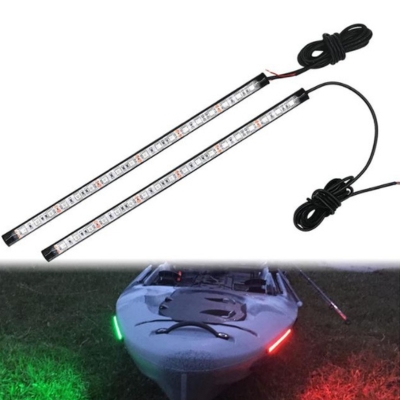
Obcursco makes a great boat navigation light kit. This LED navigation light is perfect for low light settings and rough weather with a 12v DC power and IP67 waterproof rating.
It is corrosion-resistant and impact-proof thanks to the ABS material while tightly sealed LEDs ensure full waterproofing. With easy installation using 3M adhesive it is a versatile option for boats and land use alike.
- Easy to adjust lights
- Waterproof and has durable materials
- Easy to install
- Might need to glue the lights in addition to the 3M tape
- Does not include instructions
Linkstyle Marine Boat Navigation Lights

Linkstyle's marine LED boat navigation lights are a durable and versatile option for various boat types. Its corrosion-resistant design features waterproof red and green LED units, an ABS plastic casing with a stainless steel enclosure, and polycarbonate-lenses lamps.
The lightweight and easy-to-install design is ideal for hunting and fishing. The 225-degree mounting angle ensures maximum luminance and safety compliance. These IP65 waterproof safety lamps use 16 LED bulbs powered by a 12V battery to widen visibility during reduced visibility conditions.
- Lightweight and durable to outdoor marine conditions
- Easy installation
- Ideal for smaller boats
- Installing wrong may cause navigation issues
- Not meant for larger boats
OPT7 Aura PRO LED Kit

The OPT7 Marine LED Kit is for hassle-free and waterproof boat lighting. It features SoundSync bass-activated technology, a handheld remote, and one-touch color selection with advanced dimming options.
The kit contains four LED strips, connectors, extension wires, power harness, mounting kit, and other accessories. This beats looking for everything individually but the price point might deter some buyers wanting a simple setup.
- Super bright lighting
- Easy to install and plug into 12 volt power
- Comes with remote and various light features
- Remote is not the best quality
- Might be overpriced for those wanting a simpler LED kit
Interwebz Boat Bow Navigation

Interwebz has waterproof LED bow navigation lights in red and green for boats that can be connected to a 12-volt battery or a standard pole. Proper labeling is required for night trips.
It has stylish mounting options for the boat's rub rail with a black cover that blends in with the exterior surfaces. Suitable for various boats such as bass, ski, and fishing boats, the lights are weatherproof with an IP68 rated silicone casing.
- Easily seen lighting
- Has six foot cord to connect anywhere on the boat
- Great weatherproof rating
- Likely have to use marine grade silicone to keep it secure
PryEU Daylight White

The PryEU Daylight White 6000K is an energy-efficient and versatile waterproof lighting fixture that uses 3M double-sided foam tape for secure attachment. It has a 12v DC voltage compatibility and consumes only 1.5 watts and makes it ideal for marine interiors and other spaces.
Installation is easy but it involves surface cleaning and sticking it to the adhesive backing. A three year warranty plus 60 days replacement and fast delivery with customer support are provided by the manufacturer.
- Excellent energy efficiency
- Solid waterproof rating
- Easy to install and has three year warranty
- Might need silicone to help make it stay
- Lights cannot be dimmed
Amzonly LED Navigation Lights
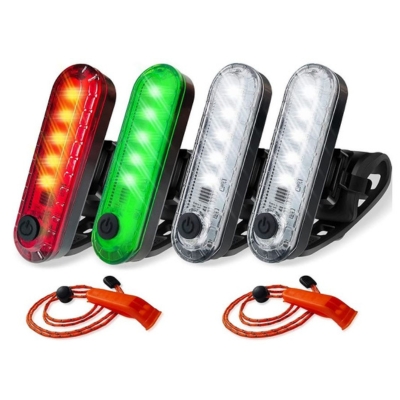
AMZONLY LED boat navigation lights are a versatile and top-rated kit with red and green LEDs for the bow and port side and white for the stern. They have three flashing modes and a magnetized screwdriver for easy battery changes.
This IPX5 weather-resistant light kit comes with four LEDs, 12 3-volt batteries, three elastic straps, one long armband, and a 12-month return policy. This is suitable for kayaks, yachts, motorboats, and pontoons and they can be used as a flush mount navigation light, masthead light, taillight, running light, or flashing light.
- Easy to install kit with everything you need
- One year return policy
- Solid waterproof and weatherproof capabilities
- Not intended to be submerged or soaked
Leaningtech LED Boat Navigation Lights

The LEANINGTECH Marine LED is a waterproof and adaptable lighting choice for boats that is known for its brightness, energy efficiency, and USCG compliance. Its durable construction from ABS plastic and chrome plaid zinc ensures both lightweight and waterproof properties with an IP65 rating.
It can serve various purposes that as a source of lighting for different types of boats. It can also serve as a bow, running, or stern light.
- Great brightness
- Easy to install and is made from quality materials
- Has multiple functions for use
- Gauge for wires is a bit small
- Some reports say it did not hold up well in salt water conditions
Osinmax Boat Navigation Light
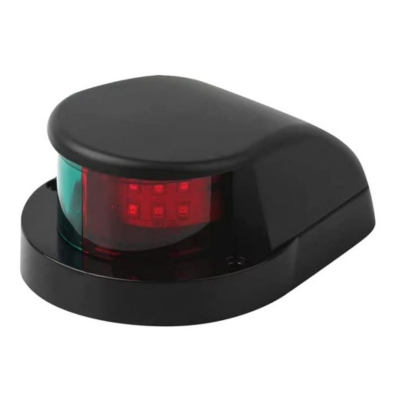
The Osinmax LED boat navigation lights is a top-rated energy-saving set that uses a 3W LED bulb and 12V DC power. With green and red lenses it offers masthead-like running lights that ensure you will be seen up to two miles.
The housing is waterproof with an IP67 high-density seal ring made of foam silicone rubber that helps prevent short circuits from splashes. The lights comply with maritime navigation, wildlife, and fisheries regulations, and install easily with one screw.
- Low power consumption and is super bright
- Designed to keep water out
- Can be used as courtesy lights
- Might need to add silicone to adhere the back side
- Might be difficult to install on some boats
Lumitec SeaBlazeX Boat Navigation Lights

To attain premium illumination you should opt for the Lumitec SeaBlazeX LED with 12-24V DC power that emits 4,000 lumens. Its marine-grade bronze housing enables convenient flat surface installation.
It offers versatile programmable features such as cross-fade and strobe. Perfect for subaquatic use, preventing discoloration, it is available in blue, green, white, and white/blue hues.
- Durable in salt water conditions
- Solid underwater submersion capabilities
- Bright lights in various colors
- Cannot dim lights
- Somewhat expensive compared to similar brands
Five Oceans Boat Navigation Lights

Boaters prefer Five Oceans' marine LED boat navigation lights for clear visibility up to two miles. These dual-function green and red lights serve as stern, flushing, and bow lights.
They are made of lightweight ABS plastic and alloy covers.They are also brighter and longer-lasting compared to other boat navigation lights.
These low-tension safety lights connect to a 12V power source for energy efficiency and superior visibility. With a UV-resistant feature and a lifespan of about 50,000 hours they are top choice. No additional sealing is required thanks to their rubber seal.
- IP66 protection and endure splashes
- Easily install the 3W bi-color LEDs at a 225-degree angle using the included screws
- Bright boat navigation lights that can be seen two miles away
- Does not look as appealing as other boat navigation lights
What to Expect from LED Boat Navigation Lights
To simplify your selection process when looking for LED lighting fixtures to accessorize, you will need to research a variety of factors based on your needs. If you wish to upgrade or replace your boat navigation lights here are some key factors to consider.
Lighting Capability
LED lights have evolved to meet diverse lighting needs with some producing clear white light and others providing brightness from any direction. Lumens is the term used to describe the amount of light generated by a particular brand of LED lights.
Angle of the Lights
To avoid eye damage it is crucial to factor in the beam angle when purchasing LED boat lights. Read reviews from past customers to gauge the intensity of the light directed at you or from an angle. Strong LED lighting fixtures can harm your eyes so be cautious.
Energy Efficiency
Comparing the percentage of energy needed to produce sufficient light is crucial when selecting lighting fixtures such as LED lights. Higher lumens per watt make LED lights more cost-effective in terms of energy consumption.
Red Light Output
Excessive heat generation in boat LED lights is a significant concern for buyers. To ensure optimal lighting quality it is crucial to consider the heat output of the chosen LED light.
Ease of Installation
Multiple installation techniques for navigation lights cater to different boating needs but mount components should be ensured for both wired and battery-operated choices. Mounting options range from screws to armbands.
Wired lights are recommended for safety while small boats can benefit from the versatility of battery-operated LED lights. The chosen installation method impacts functionality, service life, and safety, ultimately safeguarding lives and property.
LED light prices will vary depending on select features such as materials used and the manufacturer's design availability. Choosing a manufacturer depends on the buyer's budget and preferences for the intended use of the boating adventure.
Customized features and extended warranty may result in higher prices. To obtain the finest LED light bargain you should scrutinize LED boat lighting warranties that typically span from one to seven years. Do not settle for one that is the cheapest option since it might not suit your intended use or last as long as you may hope.
Quality Materials
To ensure the longevity of LED lights it is crucial for prospective buyers to consider the material used. If the material is prone to rust then the light will eventually corrode.
Always check the manufacturer's material-composition and avoid products made primarily of alloy coating. You should for opt for a top-grade metal or alloy material from a reputable LED light brand.
Your lighting source must be tightly sealed and capable of withstanding harsh weather and moisture. When using LED lights for marine and saltwater expeditions, verify the IP rating.
Look for an IP67 rated LED product. This means it confirms its ability to endure any weather conditions and even some underwater submersion.
Why You Need LED Boat Navigation Lights
LED navigation lights offer numerous benefits. They primarily are designed to allow safe transport on the waterways so that other boats can see you.
Choose quality LED lights for greater energy efficiency and significant cost savings compared to incandescent bulbs. LED lights have diverse uses on land and sea, being useful for lighting homes, businesses, and buildings.
Marine LED cabin lights have become popular as decorative lighting inside homes, while others use LEDs for entertainment, transportation, spotlighting, or reading. LEDs are considered essential lighting tools in any setting.
Other reasons to have efficient ones include:
- Easy installation and durable marine-grade construction
- Versatile performance options based on different brands
- Improved visibility for boat status and navigation
- Helps prevent accidents caused by extreme weather and reduced visibility
- Retain compliance with wildlife and marine laws
- Multiple usage options in other marine applications
Differences in LED Boat Navigation Lights
The boat light packaging is compact upon delivery and LED lights operate similarly to incandescent bulbs. They are initially designed for lighting boats but a lot of these lights now serve multiple purposes and come in various types.
- Navigation: Are essential for indicating the position and direction of sea vessels. Usually with red and green lights in addition to white.
- Anchor: The anchor light serves to locate and signal the presence of a docked vessel
- White: Provides adequate lighting all around the boat
- Deck: These lights offer lighting in areas that you walk through often
- Dock: Serve as bright illumination for boaters or mariners during departure or arrival at a marina
- Underwater: These are submerged or placed near water to lure sea creatures during nighttime fishing expeditions.
- Search: Search lights are essential for boat users to locate objects on deck or in water.
Which Colors Do You Need for Your Boat?
Boat navigation lights consist of red sidelight for port side and green sidelight for starboard side. White lights serve as anchor, masthead, or stern lights.
If you cannot remember how to tell the two apart you can always think of port red wine. There is a saying that you can easily remember such as “there is no red port wine left”. This way you do not have to worry about the starboard side since it works itself out in the phrase if you can remember the port side.
Navigation lights are unnecessary for illumination during normal boat motion except in low visibility conditions. If you decide to use other lights on your boat make sure that they are not in use during lower light conditions so that other boaters are not confused by your setup.
Related Articles
I've personally had thousands of questions about sailing and sailboats over the years. As I learn and experience sailing, and the community, I share the answers that work and make sense to me, here on Life of Sailing.
by this author
Most Recent
Important Legal Info
Lifeofsailing.com is a participant in the Amazon Services LLC Associates Program, an affiliate advertising program designed to provide a means for sites to earn advertising fees by advertising and linking to Amazon. This site also participates in other affiliate programs and is compensated for referring traffic and business to these companies.
Similar Posts
Popular posts.

Best Liveaboard Catamaran Sailboats
December 28, 2023

Can a Novice Sail Around the World?
Elizabeth O'Malley
June 15, 2022

4 Best Electric Outboard Motors

How Long Did It Take The Vikings To Sail To England?

10 Best Sailboat Brands (And Why)
December 20, 2023

7 Best Places To Liveaboard A Sailboat
Get the best sailing content.
Top Rated Posts
Lifeofsailing.com is a participant in the Amazon Services LLC Associates Program, an affiliate advertising program designed to provide a means for sites to earn advertising fees by advertising and linking to Amazon. This site also participates in other affiliate programs and is compensated for referring traffic and business to these companies. (866) 342-SAIL
© 2024 Life of Sailing Email: [email protected] Address: 11816 Inwood Rd #3024 Dallas, TX 75244 Disclaimer Privacy Policy
- The A.V. Club
- The Takeout
- The Inventory
Support Quartz
Fund next-gen business journalism with $10 a month
Free Newsletters
Tail lights: Smart signals
Those simple lights on the back of your car are one of the most important technological innovations in automaking history — and they’re not finished yet..
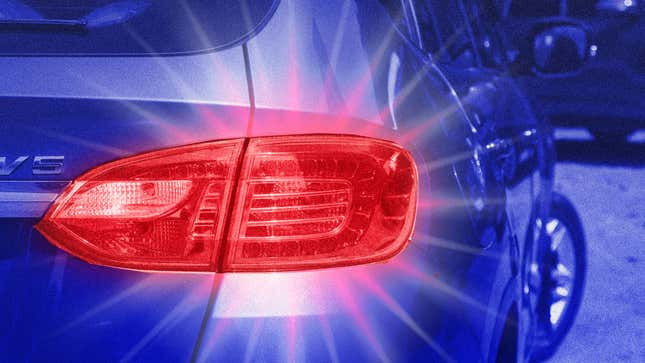
Listen on: Apple Podcasts | Spotify | Google | Pandora
You’ve seen the endless sea of red when you’re stuck in traffic. But chances are, you haven’t given the simple tail light much thought. Car designers past and present have, though — and so has Jason Torchinsky, co-founder of auto news blog The Autopian. These signals, which include the lights that indicate a car’s existence on the road, brake lights, and turn indicators, have traveled from oil lamp to bespoke brand signature over the years. All so we can show each other where we are and where we’re going. This episode is guaranteed to change how you think about any road-based journey (and it might involve a little tail light fan fiction, too). Read the full transcript here.
Gabriela Riccardi is news editor at Quartz and the host of Season 7 of the Quartz Obsession podcast. She’s obsessed with zinemaking, her glassware collection, and karaoke (if Carole King is on).
Jason Torchinsky is co-founder of The Autopian . He’s obsessed with tail lights, of course.
Murder By Flashing Amber Light: A Mack Hardigraw Car Mystery — your must-read taillight crime fiction by Jason Torchinsky, at The Autopian
How Taillights Caused A ‘Riot’ And Jail-Break In Small-Town Kansas In 1916
Volkswagen Tail Light “Signatures”
The Quartz Obsession is produced by Ready Freddie Media, with additional support from executive editor Susan Howson and head of video David Weinstein. Our theme music is by Taka Yasuzawa and Alex Suguira. This episode was recorded at G/O Media headquarters in New York and at Jason’s home studio in North Carolina.
📬 Sign up for the Daily Brief
Our free, fast, and fun briefing on the global economy, delivered every weekday morning.
- Skip to main content
- Keyboard shortcuts for audio player
In a boost for EVs, EPA finalizes strict new limits on tailpipe emissions

Camila Domonoske
Michael Copley

Morning traffic fills the SR2 freeway in Los Angeles, California. The EPA released new rules for vehicle emissions that are expected to cut tailpipe pollution and greenhouse gas emissions, which are fueling climate change. David McNew/Getty Images hide caption
Morning traffic fills the SR2 freeway in Los Angeles, California. The EPA released new rules for vehicle emissions that are expected to cut tailpipe pollution and greenhouse gas emissions, which are fueling climate change.
After nearly a year of frantic lobbying and debate, the EPA has finalized strict new rules on vehicle emissions that will push the auto industry to accelerate its transition to electric vehicles.
The EPA expects that under the new rules, EVs could account for up to 56% of new passenger vehicles sold for model years 2030 through 2032, meeting a goal that President Biden set in 2021 .
The regulations are a cornerstone of the Biden Administration's efforts to fight climate change.
Combined with investments the U.S. is making in battery and electric vehicle manufacturing, the auto regulations will help shift the U.S. away from relying on fossil fuels for transportation, a senior administration official said during a call with reporters.
"Three years ago, I set an ambitious target: that half of all new cars and trucks sold in 2030 would be zero-emission," Biden said in a statement, adding that the country will meet that goal "and race forward in the years ahead."
Biden added that U.S. workers "will lead the world on autos making clean cars and trucks, each stamped 'Made in America. '"
The new rules require auto manufacturers to slash emissions of greenhouse gasses like carbon dioxide that are heating the planet, as well as air pollutants that contribute to soot and smog. The administration says the new standards will avoid more than seven billion tons of carbon dioxide emissions and deliver almost $100 billion in annual benefits, including $13 billion in health benefits as a result of less pollution.
"That's going to have immediate benefits in improving air quality, but also improving people's health," Cara Cook, director of programs at the Alliance of Nurses for Healthy Environments, told reporters ahead of the EPA's announcement. "So they're not breathing in dirty air, especially for those who are living near major roadways and highways, heavy traffic [areas]. Those are the ones that are going to really experience a significant amount of benefits from these rules."
Entire fleets, not individual cars, must meet strict rules
The rules cover light- and medium-duty vehicles — cars, SUVs, vans and pickup trucks, but not 18-wheelers — from model years 2027 to 2032.
For light-duty vehicles, the EPA expects the rules will result in an industry-wide average emissions target of 85 grams of carbon dioxide per mile, representing an almost 50% reduction compared to existing standards for model year 2026 vehicles. The agency expects the average CO2 emissions target for medium-duty vehicles to fall by 44%.
The EPA rules are not written as an EV mandate or a ban on the sale of gas cars, like some states and other countries have adopted. Instead, the EPA sets standards that apply across an entire fleet — meaning an automaker still can make vehicles with higher emissions, as long as they also make enough very low or zero-emission vehicles that it averages out.
That means over the next decade, automakers can continue to offer a range of vehicle types, but the "menu" that's available to consumers will shift to be cleaner overall.
The rules will likely drive a shift not just among automakers, but among their suppliers and in infrastructure, says Thomas Boylan, regulatory director at the Zero Emission Transportation Association, which advocates for electric vehicles.
"I think it creates a substantial tailwind in the EV market itself, but I think it's even more pronounced throughout the supply chain" for things like parts manufacturing and charging infrastructure, Boylan said.
"It's really that full supply chain that has an additional level of certainty with these types of rules."
The EPA says consumers will also be able to opt for gas-powered vehicles with particulate filters and gas-electric hybrids.
Electric vehicles have higher price tags, on average, than gas-powered vehicles, although the gap has been narrowing and federal tax credits sometimes exceed the difference. Consumer groups have expressed support for the EPA's rules, noting that EVs save drivers money over the life of the vehicle because it's almost always cheaper to charge than to fuel up. Researchers last year found the proposed rule would save all drivers money , with the biggest savings for lower-income Americans.
The EPA says it expects the new rules will deliver fuel savings to consumers of up to $46 billion annually, plus savings on maintenance and repairs that the agency values at $16 billion annually.
"This is one of the biggest pieces of climate regulation in history," Chris Harto, senior policy analyst for transportation and energy at Consumer Reports, said on a call with reporters.
"It's going to have opponents," Harto added, because the money consumers will save is "coming out of the pockets of the oil industry."
In addition to reducing greenhouse gas emissions, the rules also call for a reduction in other types of tailpipe pollution. A senior Biden administration official said those pollution regulations will reduce hospitalizations and prevent 2,500 premature deaths in 2055.
Auto industry asked for a slower start
The auto industry is in the midst of a dramatic transformation, with virtually all major companies pivoting toward making electric vehicles — albeit at different speeds.
In the U.S., EV sales increased by 50% last year, to just under 10% of new car sales. Automakers are also looking to Europe and China, which have embraced the idea of an electric future, and shifting their global plans accordingly.
But U.S. charging infrastructure is not increasing fast enough to keep pace with EV growth. Most EVs for sale right now are luxury vehicles, with relatively fewer options on the cheaper end of the scale. And, significantly, legacy automakers are making far more money on their gas-powered vehicles than their EVs, some of which are not yet profitable at all.
The Alliance for Automotive Innovation, a trade group representing auto manufacturers, asked the EPA to adjust the timeline for the new rules, dialing down the ambition for the next few years and then cranking up the pace toward the end of the time frame. The United Auto Workers union made a similar appeal.
The approach reflected what the Alliance calls a "Goldilocks problem": automakers see huge risks if they move too slowly or too quickly toward EVs.
Of course, the auto industry is not a monolith. All-electric automakers like Tesla and Rivian encouraged the EPA to set even more stringent rules. Dealers, who have generally been more skeptical of EVs than manufacturers, sharply criticized the EPA's original proposed rules.
The final rules the EPA settled on reflect the input from auto makers, labor unions and car dealers, a senior administration official said. Manufacturers will be able to make more gradual cuts to emissions in the early years, the official said, but the rules will ultimately deliver the same reductions as the agency's initial proposal.
The oil industry is fundamentally opposed
The oil industry, meanwhile, has been an even more vocal critic of these rules and other policies promoting EVs. Rising adoption of electric vehicles is expected to reduce oil demand over time, although it will take decades for the global fleet of vehicles to turn over.
Oil trade groups call the new EPA rule a ban on gas-powered cars, although the regulations allow the continued sale of gas vehicles. The American Petroleum Institute has said the rule "threatens consumer freedom, energy reliability and national security."
The American Fuel and Petrochemical Manufacturers, which has spent millions on ads against the EPA rules and other policies, also criticized the EPA for not considering the environmental impact of manufacturing a giant battery or charging an EV. A large body of research has found that even with those impacts factored in , EVs are still vastly better for the planet than comparable fossil fuel vehicles. It's true, however, that larger, less efficient EVs have a bigger environmental footprint than smaller ones.
But the oil industry's opposition goes even further. The attorney general of Texas has previously filed a lawsuit challenging the EPA's authority to set rules designed to promote electric vehicles. Multiple oil trade groups backed Texas in the case. The auto industry sided with the EPA, noting that carmakers are investing billions in going electric and that reducing greenhouse gas emissions is a "national priority."
In fact, cutting greenhouse gas emissions is a global priority. The world has now agreed that transitioning away from fossil fuels is key to reducing the devastating impacts of climate change that, even in the best-case scenario, will disrupt ecosystems and human lives around the world.
And as the EPA sets rules designed to accelerate the shift away from fossil fuels, carmakers and oil producers are responding very differently.
The auto industry sees a profitable zero-emissions future for itself — if it can figure out how (and when) to get there. The oil industry is fighting to defend its core product.
On a call with reporters earlier this month, Chet Thompson, the CEO of the AFPM, lambasted media reports that the EPA was considering a "compromise" that would give the auto industry a few more years of more lenient standards, buying companies time to prepare for the EV transition.
Thompson emphasized that the EPA rules would still be, fundamentally, aimed at making most cars sold in the U.S. run on batteries.
"At 2032, it's the same outcome," Thompson said, frustrated. "This administration should not be calling that a compromise when in fact, they want to take us to the same place."
- electric vehicles

An official website of the United States government
Here’s how you know
Official websites use .gov A .gov website belongs to an official government organization in the United States.
Secure .gov websites use HTTPS A lock ( Lock A locked padlock ) or https:// means you’ve safely connected to the .gov website. Share sensitive information only on official, secure websites.
JavaScript appears to be disabled on this computer. Please click here to see any active alerts .
Final Rule: Multi-Pollutant Emissions Standards for Model Years 2027 and Later Light-Duty and Medium-Duty Vehicles
- 40 CFR Part 19
- 40 CFR Part 86
- 40 CFR 1066
- 40 CFR 1867
- EPA-HQ-OAR-2022-0829
On this page:
Rule summary, rule history, additional resources.
- Regulations for Greenhouse Gas Emissions from Passenger Cars and Trucks
- Clean Trucks Plan
Para información en español, haga clic aquí .
On March 20, 2024, EPA announced a final rule, Multi-Pollutant Emissions Standards for Model Years 2027 and Later Light-Duty and Medium-Duty Vehicles, that sets new, more protective standards to further reduce harmful air pollutant emissions from light-duty and medium-duty vehicles starting with model year 2027. The final rule builds upon EPA’s final standards for federal greenhouse gas emissions standards for passenger cars and light trucks for model years 2023 through 2026 and leverages advances in clean car technology to unlock benefits to Americans ranging from improving public health through reducing smog- and soot-forming pollution from vehicles, to reducing climate pollution, to saving drivers money through reduced fuel and maintenance costs. These standards will phase in over model years 2027 through 2032.
- Final Rule: Multi-Pollutant Emissions Standards for Model Years 2027 and Later Light-Duty and Medium-Duty Vehicles (pdf) (9 MB, pre-publication, signed March 2024)
- Proposed Rule: Multi-Pollutant Emissions Standards for Model Years 2027 and Later Light-Duty and Medium-Duty Vehicles
- Fact Sheet: Multi-Pollutant Emissions Standards for Model Years 2027 and Later Light-Duty and Medium-Duty Vehicles (pdf) (311.3 KB, March 2024, EPA-420-F-24-016)
- Fact sheet in Spanish: Normas de emisiones multicontaminantes para vehículos de servicio liviano y mediano de los años 2027 y posteriores: regla final (pdf) (319.1 KB, March 2024, EPA-420-F-24-017)
- Regulatory Impact Analysis: Multi-Pollutant Emissions Standards for Model Years 2027 and Later Light-Duty and Medium-Duty Vehicles (pdf) (17 MB, March 2024, EPA-420-R-24-004)
- Response to Comments: Multi-Pollutant Emissions Standards for Model Years 2027 and Later Light-Duty and Medium-Duty Vehicles (pdf) (28.2 MB, March 2024, EPA-420-R-24-005)
- Air Quality Analysis for the Light and Medium: Duty Vehicle Multipollutant Rule - Memo to the Docket (pdf) (18 MB, March 2024, EPA-420-R-24-008)
- EPA’s OMEGA model runs and files supporting the final rule's benefit-cost and effects analysis
- Regulations for Emissions from Vehicles and Engines Home
- Greenhouse Gas
- Central Oregon
- Oregon-Northwest
- Crime Stoppers
- KTVZ.COM Polls
- Special Reports
- NewsChannel 21 Investigates
- Ask the Mayor
- Interactive Radar
- Local Forecast
- Snow Report
- Road Conditions – Weather Webcams
- Prep Scoreboard
- Livestream Newscasts
- Livestream Special Coverage
- Local Videos
- Photo Galleries
- 21 Cares For Kids
- Community Billboard
- Community Links
- One Class At a Time
- Pay it Forward
- House & Home
- Entertainment
- Events Calendar
- Pump Patrol
- Pet Pics Sweepstakes
- Sunrise Birthdays
- Submit Tips, Pics and Video
- KTVZ Careers
- Central Oregon Careers
- Email Newsletters
- Advertise with NPG of Oregon
- Careers and Internships
- Closed Captioning
- Download Our Apps
- EEO Public Filing
- FCC Public File
- NewsChannel 21 Team
- On-Air Status
- Receiving KTVZ
- TV Listings
DCSO offers mandatory Boater Education card exams, pre-season boat inspections
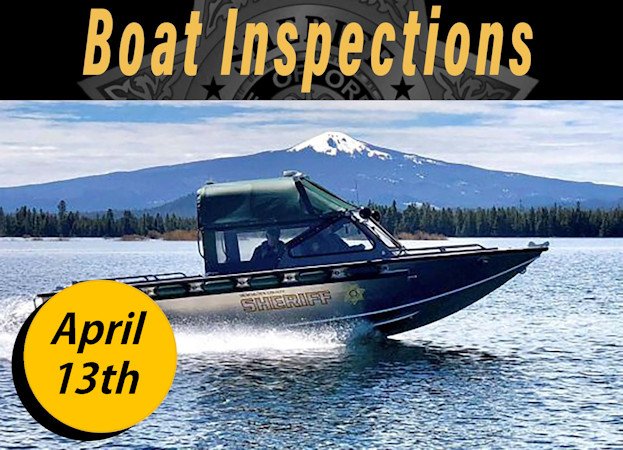
BEND, Ore. (KTVZ) -- The Deschutes County Sheriff’s Office Marine Unit is pleased to announce the return of our free mandatory Boater Education card proctored examination, as well as a pre-season opportunity to have your motorized boat inspected.
Oregon law requires Oregon residents 16 years of age and older who operate powered boats of more than 10 horsepower, to obtain their Mandatory Boater Education card. Failure to have a card under the above conditions might result in a $142 fine.
This card is not a license to operate a boat, as there is no such requirement in Oregon. Once a boater receives their card, it never has to be renewed. There is a one-time $20 cost to receive your card and duplicate cards are available for $16.
Boat operators can also access the testing material and take the test on-line through the Oregon State Marine Board website, but there is generally a fee associated with the test and receiving a certificate. Exam participants will be shown an informational video prior to the proctored examination and will have an opportunity to ask questions.
Additional exam preparation material can be found on the Oregon State Marine Board web site under “Study Guide.” A 75-question multiple choice test will be given; a minimum score of 70% is needed to pass. The tests are graded upon completion; necessary paperwork and information on how to receive their card from the Oregon State Marine Board will be given.
The following is the schedule of classes for 2024. All exams run from 9am-12pm and are held at the Deschutes County Sheriff’s Office in Bend (63333 Hwy 20 West). There is no sign up or registration for the exam, but please arrive a few minutes prior to the start of the class to check in. For additional information, go to www.sheriff.deschutes.org, or boat-ed.com/oregon/ or contact the Sheriff’s Office at 541-388-6501.
2024 Class Dates: May 11th, June 8th, July 13th and August 24th
The Deschutes County Sheriff’s Office will also be providing an opportunity for boaters to have their boats inspected at three different locations in Deschutes County. The inspections will be offered on Saturday, April 13th, 2024, at Big Country RV in Redmond, the Main Sheriff’s Office parking lot in Bend and the Deschutes County Sheriff’s Office substation in La Pine. DCSO Marine Deputies and Volunteers will be present at the above locations on April 13th, between the hours of 9am-2pm.
Jump to comments ↓
KTVZ news sources
Related articles.

‘Dreams are coming true’: ‘Dream Boldly: The Grand AdvenChair’ film, featuring inventor Geoff Babb, to debut at COCC

Assistance League of Bend’s Operation School Bell in 31st year, provides new school clothes to thousands of students

DCSO: Alfalfa man called 911 to report he set own house ablaze, then blocked driveway to keep firefighters away

Bend-Redmond Habitat for Humanity recruiting for service opportunities through AmeriCorps
KTVZ NewsChannel 21 is committed to providing a forum for civil and constructive conversation.
Please keep your comments respectful and relevant. You can review our Community Guidelines by clicking here
If you would like to share a story idea, please submit it here .

- RV Parts & Accessories
- Power & Electrical
- Interior Lighting

Enjoy fast, free delivery, exclusive deals, and award-winning movies & TV shows with Prime Try Prime and start saving today with fast, free delivery
Amazon Prime includes:
Fast, FREE Delivery is available to Prime members. To join, select "Try Amazon Prime and start saving today with Fast, FREE Delivery" below the Add to Cart button.
- Cardmembers earn 5% Back at Amazon.com with a Prime Credit Card.
- Unlimited Free Two-Day Delivery
- Streaming of thousands of movies and TV shows with limited ads on Prime Video.
- A Kindle book to borrow for free each month - with no due dates
- Listen to over 2 million songs and hundreds of playlists
- Unlimited photo storage with anywhere access
Important: Your credit card will NOT be charged when you start your free trial or if you cancel during the trial period. If you're happy with Amazon Prime, do nothing. At the end of the free trial, your membership will automatically upgrade to a monthly membership.
Return this item for free
Free returns are available for the shipping address you chose. You can return the item for any reason in new and unused condition: no shipping charges
- Go to your orders and start the return
- Select the return method

Image Unavailable

- To view this video download Flash Player
NAOEVO RV Lights Interior 2070LX, 1500LM RV LED Lights Interior 12V, Camper Lights Interior with 3 Color and Stepless Dimming, Energy-efficient RV Ceiling Light for Trailer Boat Car 8Pack
Purchase options and add-ons, about this item.
- 【3 COLOR TEMPERATURE & MULTI-LEVEL ADJUSTABLE BRIGHTNESS】3 color options are available with rv light- Cool White(crisp, clean white illumination), Natural White(balance between bright and warm) and Warm White(softer light with hints of yellow). Also, Slide the button to multi-level adjust the brightness from 20% to 100% to further customize the light source based on your mood.
- 【High Energy Efficiency】The RV light fixture is equipped with 2 rows of 96 high-quality SMD 2835 LED chips, consuming only 10 watts of power and providing a total of 1500 lumens of brightness. RV led lights features high light output and low current consumption, preventing other appliances incapable of working due to limited power in the RV.
- 【HIGH PERFORMANCE】RV interior lights adopts heat-resistant large-size aluminum substrate, anti-scratch aluminum alloy foundation, and corrosion-resistant stainless steel screws, to realize RV lights lifespan of more than 50,000 hours. If you have any problems, you can contact us. We can offer you a free return within 2 years.
- 【EASY INSTALLATION】LED rv lights interior has 2 two wires without polarity and comes with nuts and screws. An installation instruction manual is easy to understand. It only takes 2-5 minutes to install and fix it directly in place.
- 【Wide Application】The thickness of LED camper lights is only 0.6 inches thick, slim, and space-saving. It can be easily placed in the interior spaces of various vehicles such as trailers, cars, Motorhomes, Marine Boats, and Camper to provide sufficient lighting for reading, work, leisure, and entertainment.
Frequently bought together

Similar items that may ship from close to you

Product Description

Add Intelligent Memory Function
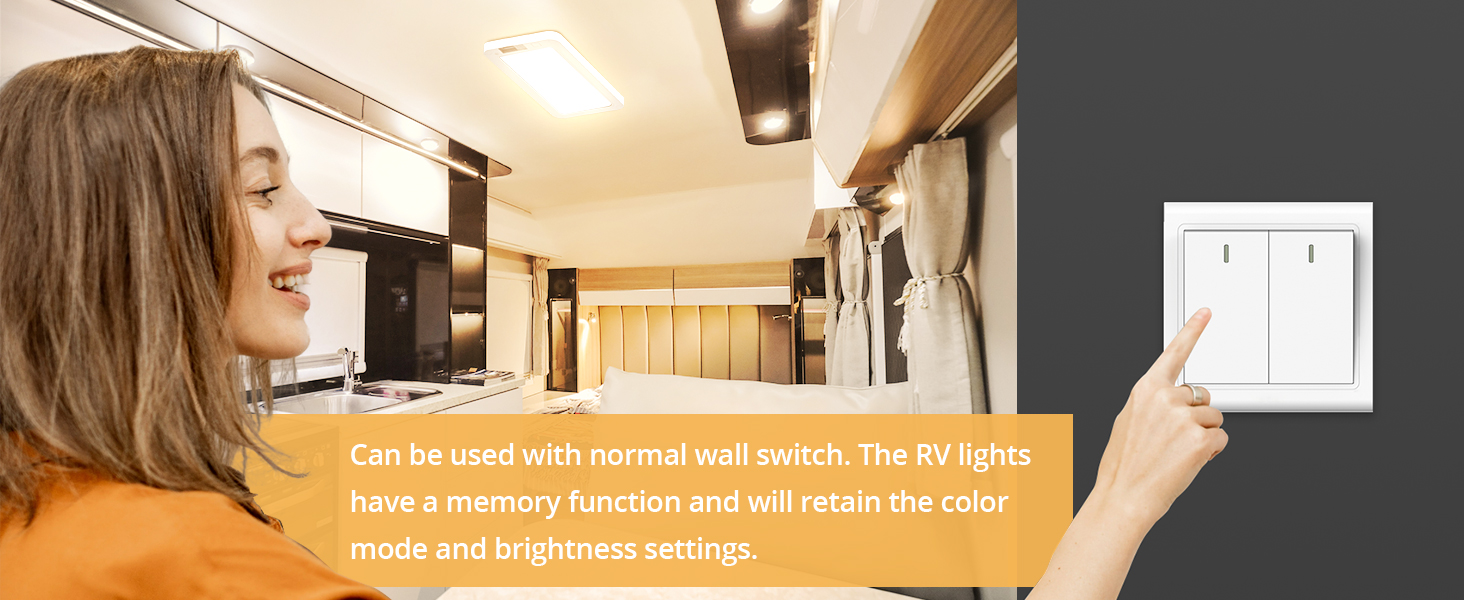
Connected To Wall Switch

How about the lighting effect?
The frosted shade of the RV lights interior provides softer light, enhanced comfort and reduced glare with no light spots. Not dazzling.
Will it fit my car?
It will fit 99% of vehicles. If you are not sure, please feel free to consult us.
How does the button work?
Press and hold 1.2S to turn off the power. Click the button to switch 3 color temperatures.
Does it work on 24v?
Yes, it works on 12v - 30v.
Are there replacement LED interior lights for when they start going bad?
Made of high-quality materials with a lifespan of over 50,000 hours. Please don't worry, our RV LED lights provide a 1-year after-sales. Don't hesitate to buy it!
Widely Used in Various Scenarios

Living Room

Dining Room

Product information
Technical details, additional information, warranty & support, compare with similar items, looking for specific info, customer reviews.
Customer Reviews, including Product Star Ratings help customers to learn more about the product and decide whether it is the right product for them.
To calculate the overall star rating and percentage breakdown by star, we don’t use a simple average. Instead, our system considers things like how recent a review is and if the reviewer bought the item on Amazon. It also analyzed reviews to verify trustworthiness.
Customers say
Customers like the appearance, value, and ease of installation of the vehicle light assembly. For example, they mention it's bright, low profile, and easy to install. That said, they appreciate the different shades of light and the value for money.
AI-generated from the text of customer reviews
Customers are satisfied with the appearance of the vehicle light assembly. They mention that the lights are great, bright, and easy to install.
"...the ability to change light color Easy to install and the look great !" Read more
"...Overall great lights and great quality 👍🏽..." Read more
" Great light , but it has the LOGO plastered on the front as pictured - it is not just image protection. Great price...." Read more
Customers find the installation process of the vehicle light assembly to be easy. They mention that it was easy enough to switch out their old dome lights.
"...My wife appreciates the ability to change light color Easy to install and the look great!" Read more
"I loved the simple installation process which made it easy enough to switch out my old dome lights. One of the lights is faulty...." Read more
"Ordered two boxes, received pretty quick, extremely easy install , wife loves them" Read more
Customers appreciate the value of the vehicle light assembly. They mention that it is a great light for the price, and has different shades of light.
"Works great,3 different shades of light, dimmable great light for the price , work perfect in our RV" Read more
"... Great price . Who wants a bunch of logos in their rv." Read more
"Bright, Low Profile and good value ...." Read more
Reviews with images

- Sort reviews by Top reviews Most recent Top reviews
Top reviews from the United States
There was a problem filtering reviews right now. please try again later..
- Amazon Newsletter
- About Amazon
- Accessibility
- Sustainability
- Press Center
- Investor Relations
- Amazon Devices
- Amazon Science
- Start Selling with Amazon
- Sell apps on Amazon
- Supply to Amazon
- Protect & Build Your Brand
- Become an Affiliate
- Become a Delivery Driver
- Start a Package Delivery Business
- Advertise Your Products
- Self-Publish with Us
- Host an Amazon Hub
- › See More Ways to Make Money
- Amazon Visa
- Amazon Store Card
- Amazon Secured Card
- Amazon Business Card
- Shop with Points
- Credit Card Marketplace
- Reload Your Balance
- Amazon Currency Converter
- Your Account
- Your Orders
- Shipping Rates & Policies
- Amazon Prime
- Returns & Replacements
- Manage Your Content and Devices
- Recalls and Product Safety Alerts
- Conditions of Use
- Privacy Notice
- Your Ads Privacy Choices

Strange Glow Over Moscow Skies Triggers Panic as Explosions Reported
B right flashes lit up the night sky in southern Moscow in the early hours of Thursday morning, new footage appears to show, following reports of an explosion at an electrical substation on the outskirts of the city.
Video snippets circulating on Russian-language Telegram channels show a series of flashes on the horizon of a cloudy night sky, momentarily turning the sky a number of different colors. In a clip shared by Russian outlet MSK1.ru, smoke can be seen rising from a building during the flashes lighting up the scene.
Newsweek was unable to independently verify the details of the video clips, including when and where it was filmed. The Russian Ministry of Emergency situations has been contacted via email.
Several Russian Telegram accounts said early on Thursday that residents of southern Moscow reported an explosion and a fire breaking out at an electrical substation in the Leninsky district, southeast of central Moscow.
Local authorities in the Leninsky district told Russian outlet RBC that the explosion had happened in the village of Molokovo. "All vital facilities are operating as normal," Leninsky district officials told the outlet.
The incident at the substation in Molokovo took place just before 2 a.m. local time, MSK1.ru reported.
Messages published by the ASTRA Telegram account, run by independent Russian journalists, appear to show residents close to the substation panicking as they question the bright flashes in the sky. One local resident describes seeing the bright light before losing access to electricity, with another calling the incident a "nightmare."
More than 10 villages and towns in the southeast of Moscow lost access to electricity, the ASTRA Telegram account also reported. The town of Lytkarino to the southeast of Moscow, lost electricity, wrote the eastern European-based independent outlet, Meduza.
Outages were reported in the southern Domodedovo area of the city, according to another Russian outlet, as well as power failures in western Moscow. Electricity was then restored to the areas, the Strana.ua outlet reported.
The cause of the reported explosion is not known. A Telegram account aggregating news for the Lytkarino area described the incident as "an ordinary accident at a substation."
The MSK1.ru outlet quoted a local resident who speculated that a drone may have been responsible for the explosion, but no other Russian source reported this as a possible cause.
Ukraine has repeatedly targeted Moscow with long-range aerial drones in recent months, including a dramatic wave of strikes in late May.
On Sunday, Moscow Mayor Sergei Sobyanin said the region's air defense systems had intercepted an aerial drone over the city of Elektrostal, to the east of Moscow. No damage or casualties were reported, he said.
The previous day, Russian air defenses detected and shot down another drone flying over the Bogorodsky district, northeast of central Moscow, Sobyanin said.
There is currently no evidence that an aerial drone was responsible for the reported overnight explosion at the electrical substation in southern Moscow.
Related Articles
- Russian Soldier Bashes Drone With Shovel After Detonation Failure: Video
- Russia Headed for Disappointment in Battles Along Dnieper River: UK
- Ukraine's Military Receives Good News From Multiple NATO Allies
Start your unlimited Newsweek trial

- Santa Barbara County
- San Luis Obispo County
- Ventura County
- U.S. / World
- Crime and Safety
- What’s Right
- News Channel 3 Investigates
- Local Forecast
- Interactive Radar
- SkyCam Network
- Full Election Results
- Election Coverage
- High School Sports
- College Sports
- More Sports
- Friday Football Focus
- News Channel 3-12 Livestream
- Livestream Special Coverage
- Morning News Guest Segments
- Events Calendar
- Entertainment
- Health Connections
- 805 Professionals
- Work For Us
- 805 Careers
- Advertise with Us
- Closed Captioning
- Download Our Apps
- EEO Public File Report
- FCC Public File
- How to find News Channel 12
- Public File Help
- Jobs and Internships
- Meet the Team
- Newsletters/Alerts
- TV Listings
Weeping, weak and soaked, dozens of Rohingya refugees rescued after night on hull of capsized boat
By REZA SAIFULLAH and EDNA TARIGAN Associated Press
MEULABOH, Indonesia (AP) — An Indonesian search and rescue ship has located a capsized wooden boat that had been carrying dozens of Rohingya Muslim refugees, and began pulling survivors who had been standing on its hull to safety. An AP photographer aboard the rescue ship said Thursday that 10 people had been taken aboard local fishing boats and another 59 were being saved by the Indonesian craft. Men, women and children, weak and soaked from the night’s rain, wept as the rescue operation got underway and people were taken aboard a rubber dinghy to the rescue boat.
Jump to comments ↓

The Associated Press
News Channel 3-12 is committed to providing a forum for civil and constructive conversation.
Please keep your comments respectful and relevant. You can review our Community Guidelines by clicking here
If you would like to share a story idea, please submit it here .
Biden seeks to accelerate the EV transition in biggest climate move yet
The epa’s final rule follows a concession to labor unions worried about a rapid shift to electric vehicles, and a nod that ev sales are slowing.

The Biden administration finalized the United States’ toughest limits on planet-warming emissions from passenger cars and light trucks Wednesday, in a controversial bid to accelerate the nation’s halting transition to electric vehicles.
The Environmental Protection Agency rule — President Biden’s most far-reaching climate regulation yet — will require automakers to ramp up sales of electric vehicles while slashing carbon emissions from gasoline-powered models, which account for about one-fifth of America’s contribution to global warming.
But unlike last year’s proposed rule , automakers will not need to dramatically boost electric vehicle (EV) sales until after 2030. The delayed timeline reflects an election-year concession to labor unions , a key Democratic constituency that has raised concerns about a rapid shift to EVs.
In another change from the proposal, automakers could comply by boosting sales of plug-in hybrid vehicles in addition to all-electric vehicles. Plug-in hybrids have recently proved more popular with U.S. consumers, in part because of concerns about a lack of public charging infrastructure.
The final rule will still prevent 7.2 billion metric tons of carbon emissions from entering the atmosphere through 2055, according to the EPA. It will also reduce fine particulate matter and nitrogen oxides, preventing up to 2,500 premature deaths from air pollution annually starting in 2055, the agency said.
“Our final rule delivers the same — if not more — pollution reduction than we set out at proposal,” EPA Administrator Michael Regan said on a call with reporters Tuesday previewing the announcement. “These final standards will also reduce some of the most serious pollutants that impact public health.”
Republican-led states and fossil fuel companies are likely to challenge the rule in court. But the Alliance for Automotive Innovation, a trade group whose members include Ford, General Motors, Stellantis and Toyota, praised the EPA’s decision to delay the stricter EV requirements until after 2030.
“Moderating the pace of EV adoption in 2027, 2028, 2029 and 2030 was the right call,” John Bozzella, president and CEO of the alliance, said in a statement. “… These adjusted EV targets — still a stretch goal — should give the market and supply chains a chance to catch up.”
U.S. EV sales have cooled in recent months. According to estimates from Kelley Blue Book, U.S. EV sales increased year-over-year by 40 percent in the fourth quarter of 2023, down from a 49 percent jump in the third quarter and a 52 percent spike in the second quarter.
Albert Gore, the executive director of the Zero Emission Transportation Association and the son of former vice president Al Gore, said other figures paint a more encouraging picture. He noted that a record 1.2 million EVs were sold in the United States last year, bringing EVs’ market share to 7.6 percent in 2023 compared with 5.9 percent in 2022.
“Whether or not we’re talking about a real slowdown, the trend line for EVs has been one of phenomenal growth over the last couple of years,” Gore said.
The price of EVs is also plunging so fast that they’re now almost as cheap as gas-powered cars. The average price difference last month was $5,000, according to data from Cox Automotive.
Still, the recent sales slowdown has prompted some automakers to scale back their EV plans, with Ford slashing production of the much-touted F-150 Lightning electric pickup truck. Many automakers are now pivoting to better-selling plug-in hybrids — a compromise between the internal combustion engines of the past and the batteries of the future.
Wednesday’s rule comes after a contentious back-and-forth between the United Auto Workers and the Biden administration over whether — and how — the shift to EVs will benefit workers.
In September, the UAW launched a historic strike against Detroit’s three biggest automakers — Ford, General Motors and Stellantis. The workers warned that the rise of EVs could erase well-paying jobs in the auto industry, since many EV plants are being built in Southern states less friendly to union labor.
Despite these warnings, the EPA issued an ambitious proposed rule last April that called for EVs to account for 67 percent of all new passenger car and light-duty truck sales by 2032. Weeks later, UAW President Shawn Fain wrote that the union was withholding its endorsement of Biden’s reelection campaign over “concerns with the electric vehicle transition.”
The union reversed course and coalesced around Biden after the EPA signaled it would relax the timeline in the final rule. The UAW endorsed the president at its annual legislative conference in January, and Fain attended Biden’s State of the Union address this month.
Automakers could still comply with the final rule by making EVs account for 67 percent of new car sales in 2032, according to the EPA. But they could also meet the requirements by making all-electric vehicles account for 56 percent and making plug-in hybrids represent 13 percent, the agency said.
Former president Donald Trump , the presumptive Republican presidential nominee, has called Fain a “dope” and has repeatedly bashed Biden’s EV goals. He has falsely claimed that EVs cannot travel far on a single charge, and he has pledged to scrap the EPA rule on day two of a second term.
On Monday, Trump sought to defend his declaration over the weekend that there would be a “bloodbath” if he lost in November, saying he was merely describing a bloodbath for the auto sector. He wrote on his social media platform that he was “simply referring to [EV] imports” allowed by Biden, which he said “are killing the automobile industry.”
Manish Bapna, president and CEO of NRDC Action Fund, the political arm of the Natural Resources Defense Council, criticized Trump’s anti-EV rhetoric.
“The industry is betting its future on electric cars, drivers are buying them in record numbers and last fall’s UAW agreement makes sure workers benefit,” Bapna said in an email. “Biden’s got a strategy to support that shift. Trump wants to slam it into reverse.”
The fossil fuel industry has sought to drum up opposition to the EPA rule, which could eat into demand for its petroleum products. The American Fuel & Petrochemical Manufacturers (AFPM), an industry trade group, has launched a seven-figure campaign against what it calls a de facto “gas car ban.” The campaign includes ads in battleground states warning that the rule will restrict consumer choice.
“To be sure, the administration refers to these regulations as ‘standards,’ not ‘bans’ or ‘mandates,’” AFPM President and CEO Chet Thompson said on a call with reporters this month. “But they do that because they know how unpopular bans are with Americans.”
The AFPM’s members include fossil fuel giants such as ExxonMobil, Chevron, Marathon Petroleum and Valero Energy. Marathon Petroleum, the nation’s largest refiner, waged a covert campaign in 2018 to roll back the car emissions standards set by President Barack Obama.
Mike Sommers, chief executive of the American Petroleum Institute, said the oil industry lobby group plans to challenge the new standards in court. “We’ll do everything we can to stop the rule,” he said in an interview Wednesday at an energy conference in Houston.
California regulators are going further than the EPA, seeking to end statewide sales of new gas cars by 2035. In the past, more than a dozen other states have opted to follow California’s tougher tailpipe pollution rules.
The California Air Resources Board announced Tuesday a deal with Stellantis , the owner of the Jeep and Ram brands. Under the deal, Stellantis agreed to comply with California’s EV sales requirements even if they are blocked by a court or a potential second Trump administration.
The automaker had previously blasted those requirements for handing rivals an unfair advantage. But on Tuesday, Stellantis CEO Carlos Tavares called the agreement a “win-win solution” that will avoid 10 million to 12 million metric tons of greenhouse gas emissions through 2030.
“The biggest and most influential companies in the world understand that this is how we can fight climate change together,” California Gov. Gavin Newsom (D) said in a statement.


IMAGES
VIDEO
COMMENTS
As such a power boat, and by extension all sailboats, MUST, without question show one green light on the starboard bow and one red light on the port bow and one all around white light or lights while operating in reduced visibility. These lights should shine at all 360 degrees of visibility with the bow lights shining at an angle of dead ahead ...
See "availability" note above. Optional Center Seat. More Info. We will contact you about shipping cost. Typically $400 - $1000. Similar to Super Snark, but sail area is 55 square feet for greater speed. Also, Sunflower has a covered foredeck, while Super Snark is completely open. Length 11 feet. Beam 3' 6".
Engine Oil Warning Light. Cars have been able to monitor their engine's oil pressure for years now. If you've seen what looks like a gravy boat light pop up in your dash it means there's a problem ...
They must show an arc of 112.5 degrees from centerline of the bow. Stern light - A white light on the stern of the boat showing an unbroken arc of 135 degrees from centerline of the vessel. All-round light - A light showing in an unbroken arc of 360 degrees. The good news is you need not measure these angles.
Nov 7, 2009. #2. Night lights. David, I agree, the more the merrier for safety, but within reason. We use a backstay mounted oil lamp for an anchor light. Your two lights at deck level may be overkill and even more confusing for other boaters. The anchorages we use regularly are so small that anything up at mast height wouldn't be seen anyway.
Only five lights rated good at 2 nm: Aqua Signal's 40100-1 bi-color light and 40400-1 masthead; Hella Marine's 62208 stern light, 62206 masthead, and 6225 tri-color. (This tricolor was actually the most visible of all the lights in the test, scoring "excellent" at 1 nm and "good" at 2 nm.) Some sidelights that were rated for only ...
Sailboat-Specific Navigation Light Rules. Sailboats must have the same red and green lights as powerboats. The difference is that you'll need other ones on the stern and mast. If your boat is less than 65 feet, you can use either a combination of a bicolor light with red and green along with another at the stern or a tricolor one on top of ...
This light has to be mounted 39 inches or more above the sidelights. Powered Vessels of 40 Feet to 130 Feet. For a slightly larger boat, you will need the same red and green sidelights mentioned above. A white stern light is also required at the back of the boat. It should be seen from at least two miles away and visible at 135 degrees.
You'll see this light being displayed on a sailboat that's either docked or at anchor. Towing Light. The towing light is a static yellow light that sits at the same position as the sternlight and displays at an arc of 135 degrees aft the vessel. As the name suggests, this light indicates to other vessels that it's currently towing an object.
23 - Power driven vessels over 12m must have a forward-facing steaming light plus sidelights and a stern light below the level of the steaming light. 25 - Sailing vessels Underway shall exhibit sidelights (red/green) as either a combined or as separate lights, and a white stern light. 30 - Anchored Vessels under 50m shall exhibit an all-round ...
Similar to standard series 40 lights, these are 8 inches tall, 3 inches in diameter, and fit 25W incandescent bulbs (no LED option). Rigged as a red/white/red RAM light, they use 75 Ah of power each night, an unacceptable amount for many cruising boats. The cost is also steep, at $120 each ($360 total).
A car review channel on TikTok called Basic A*s Car Reviews (@basicasscarreviews) uploaded a humor laden video telling drivers that the 'little blue sailboat' is warning drivers their car is too cold. "Listen up psychos," she said. "You don't just hop in the car and drive off, you have to wait until the car warms up, especially in the winter.
A steaming light is a white navigation light fitted on the mast of a sailboat to provide visibility during low-visibility conditions. It is typically placed near the front side of the mast and angled downwards to indicate that the vessel is under power and moving forward. This light helps other boats identify and avoid collisions, ensuring safe ...
Professionals and enthusiasts get their sailboat traveler cars and track hardware from Fisheries Supply. Browse products from top brands like Harken, Lewmar, Ronstan, and more. ... 22 mm Small Boat CB Track - Light Duty High Beam Endstop. SKU: 07517 | Item ID: HAR 174. In Stock. Harken Small Boat Non-captive Bearing Car Rebuild Kit. SKU: 389889 ...
YIYIBYUS Spotlight Marine Spot Light Boat Searchlight Remote Control 12V 100W White Waterproof Spotlight 360 Degree Rotate Omnibearing Lighting for Boat Truck Car Marine (White) Brand: YIYIBYUS 4.6 4.6 out of 5 stars 12 ratings
The Partsam round chrome light is a waterproof LED boat navigation light that doubles as an interior boat cabin light. It is made from top chrome bezel and high-grade plastic that make it durable and lightweight. It comes with mounting screws and is easy to install with its flush mount. It is also compatible with 12 volt DC power.
Amazon.com: UCINNOVATE 2X 6.9" Marine LED Boat Light, 3000LM 84LED Waterproof Transom Lights, Underwater Light for Yachts, Boats, Sailboat, Pontoon, Transom, Boat Deck Light Stern Lights (Blue, 12-36V, IP68) : ... COB Transom Lights Seft-adhesive Mount for Night Fishing Pontoon Boat Yacht RV Car (Cool White, 6PCS) ...
Battery Warning. Resembling a small red battery, this light lets you know that there is an issue with the electrical system. It could be anything from wiring to the alternator, but it is often a dead battery. It can also mean that the car's charging system is running on low power and that your vehicle is running largely on battery power.
Pontoon Boat Light, Marine Led Light Strip for Duck Jon Bass Boat Sailboat Kayak Flex Lighting for Boat Deck Light Accent Light Courtesy Interior Lights Fishing Night, Red, 12v. LED. 4.4 out of 5 stars. 396. $19.99 $ 19. 99. FREE delivery Tue, Mar 26 on $35 of items shipped by Amazon.
But chances are, you haven't given the simple tail light much thought. Car designers past and present have, though — and so has Jason Torchinsky, co-founder of auto news blog The Autopian ...
WASHINGTON - Today, March 20, the U.S. Environmental Protection Agency announced final national pollution standards for passenger cars, light-duty trucks, and medium-duty vehicles for model years 2027 through 2032 and beyond. These standards will avoid more than 7 billion tons of carbon emissions and provide nearly $100 billion of annual net benefits to society, including $13 billion of ...
Entire fleets, not individual cars, must meet strict rules. The rules cover light- and medium-duty vehicles — cars, SUVs, vans and pickup trucks, but not 18-wheelers — from model years 2027 to ...
The final rule builds upon EPA's final standards for federal greenhouse gas emissions standards for passenger cars and light trucks for model years 2023 through 2026 and leverages advances in clean car technology to unlock benefits to Americans ranging from improving public health through reducing smog- and soot-forming pollution from ...
Moscow Vnukovo Airport car hire. Whether you're flying into Moscow Vnukovo for a short break or a longer stay, you can take the stress out of your onward journey by hiring a car. With so many car hire companies to choose from, Skyscanner makes it easy to find the best deal.
The following is the schedule of classes for 2024. All exams run from 9am-12pm and are held at the Deschutes County Sheriff's Office in Bend (63333 Hwy 20 West).
Buy NAOEVO RV Lights Interior 2070LX, 1500LM RV LED Lights Interior 12V, Camper Lights Interior with 3 Color and Stepless Dimming, Energy-efficient RV Ceiling Light for Trailer Boat Car 8Pack: Interior Lighting - Amazon.com FREE DELIVERY possible on eligible purchases
B right flashes lit up the night sky in southern Moscow in the early hours of Thursday morning, new footage appears to show, following reports of an explosion at an electrical substation on the ...
MEULABOH, Indonesia (AP) — An Indonesian search and rescue ship has located a capsized wooden boat that had been carrying dozens of Rohingya Muslim refugees, and began pulling survivors who had ...
Moscow Vnukovo Airport car hire How to find cheap car rental in Moscow Vnukovo airport. Looking for cheap car hire in Moscow Vnukovo airport? Whether you're looking to hire a small car, people carrier, SUV, van or anything in-between, Skyscanner compares thousands of car hire deals and van rental offers to help find your perfect deal.
Despite these warnings, the EPA issued an ambitious proposed rule last April that called for EVs to account for 67 percent of all new passenger car and light-duty truck sales by 2032.